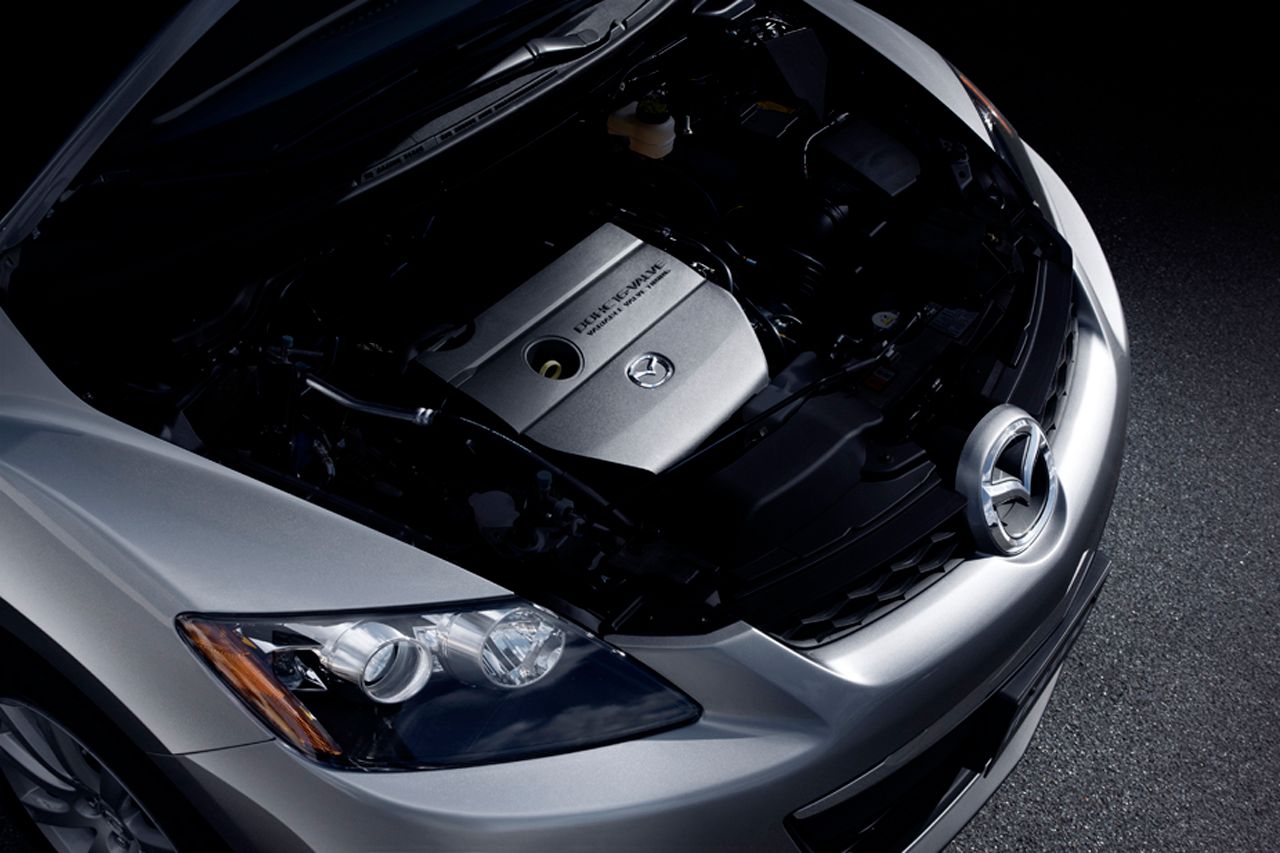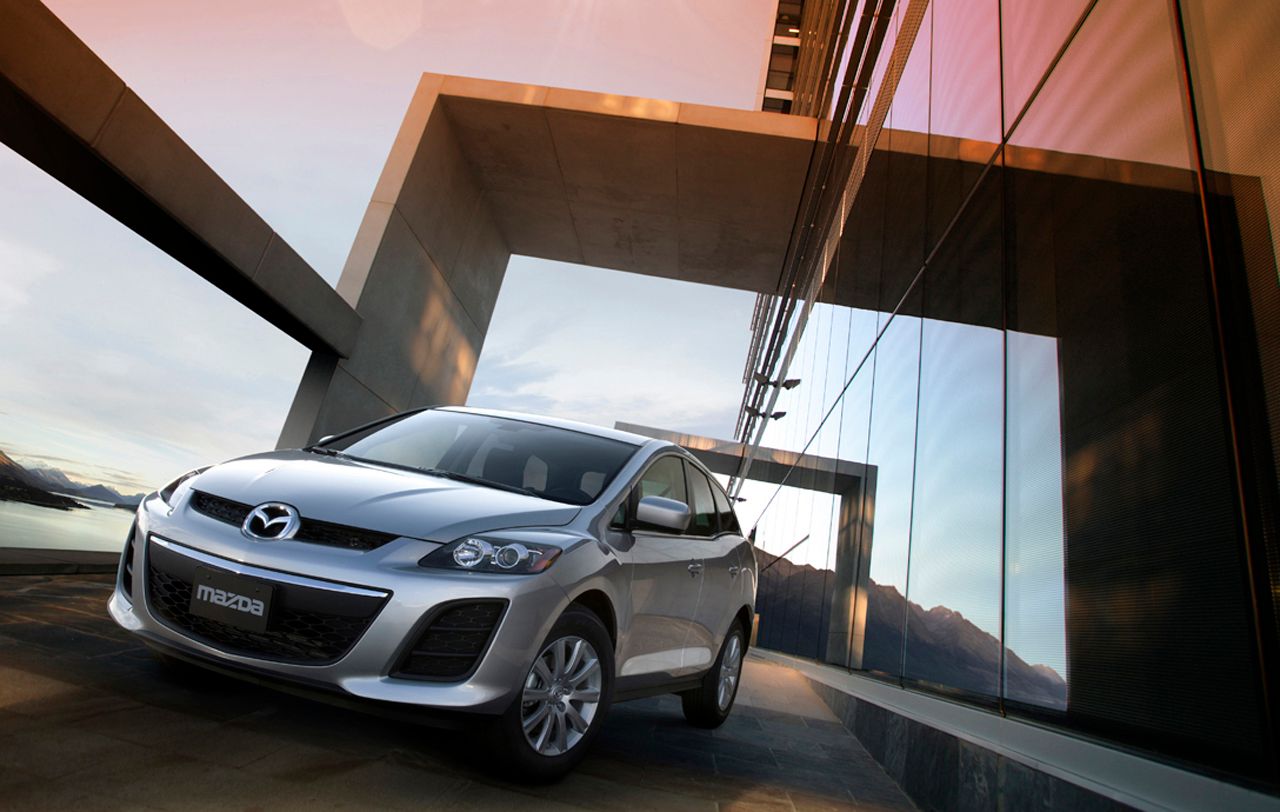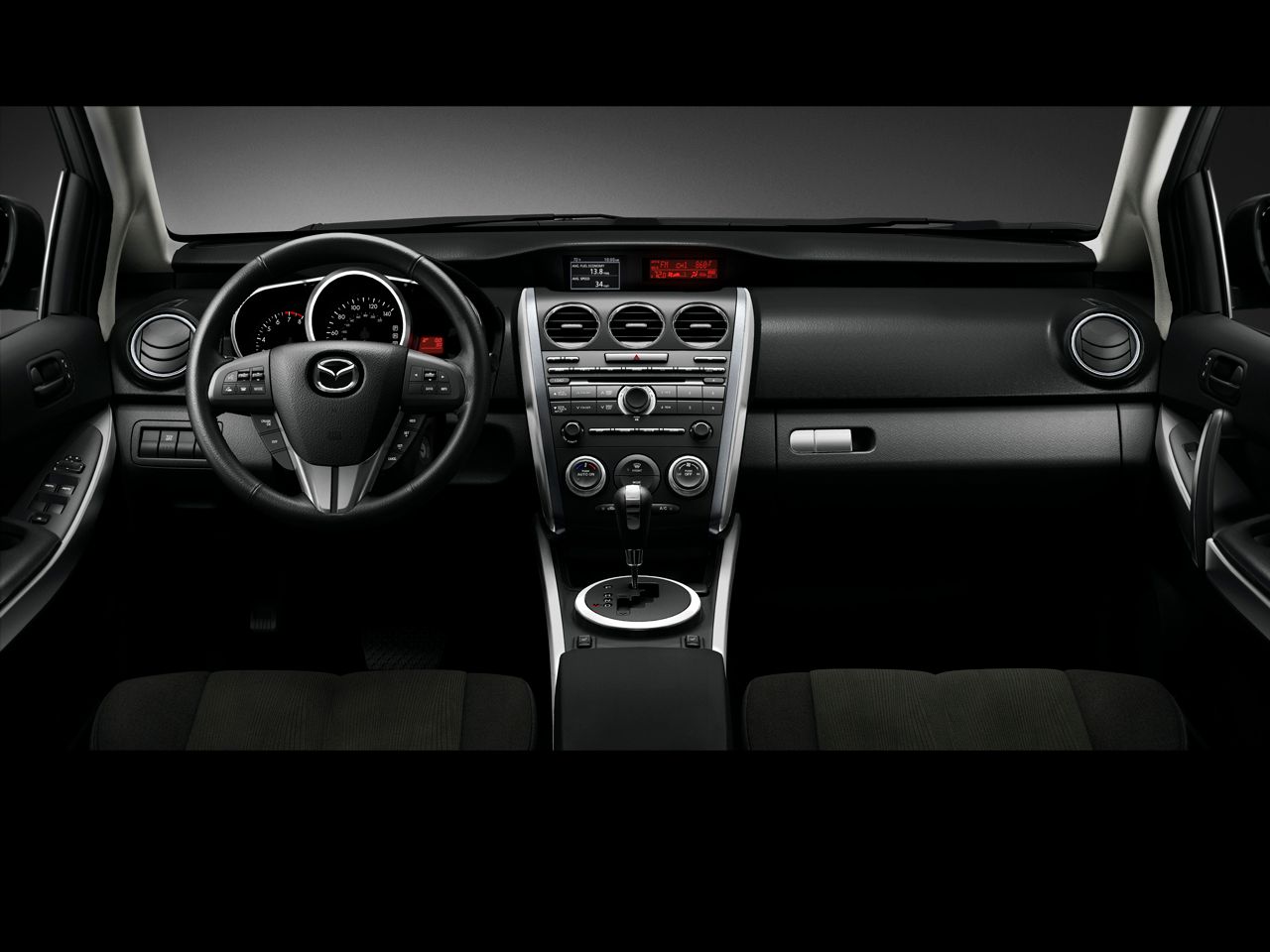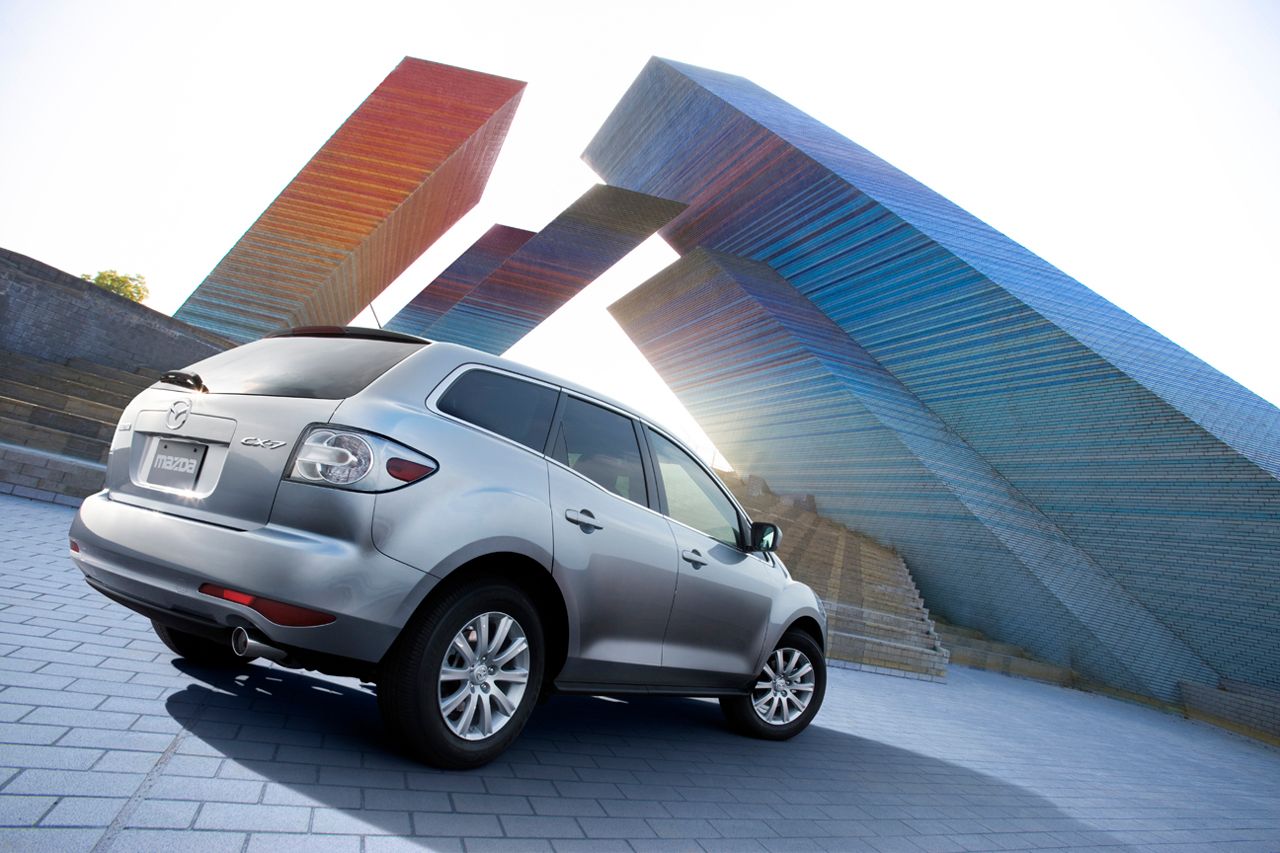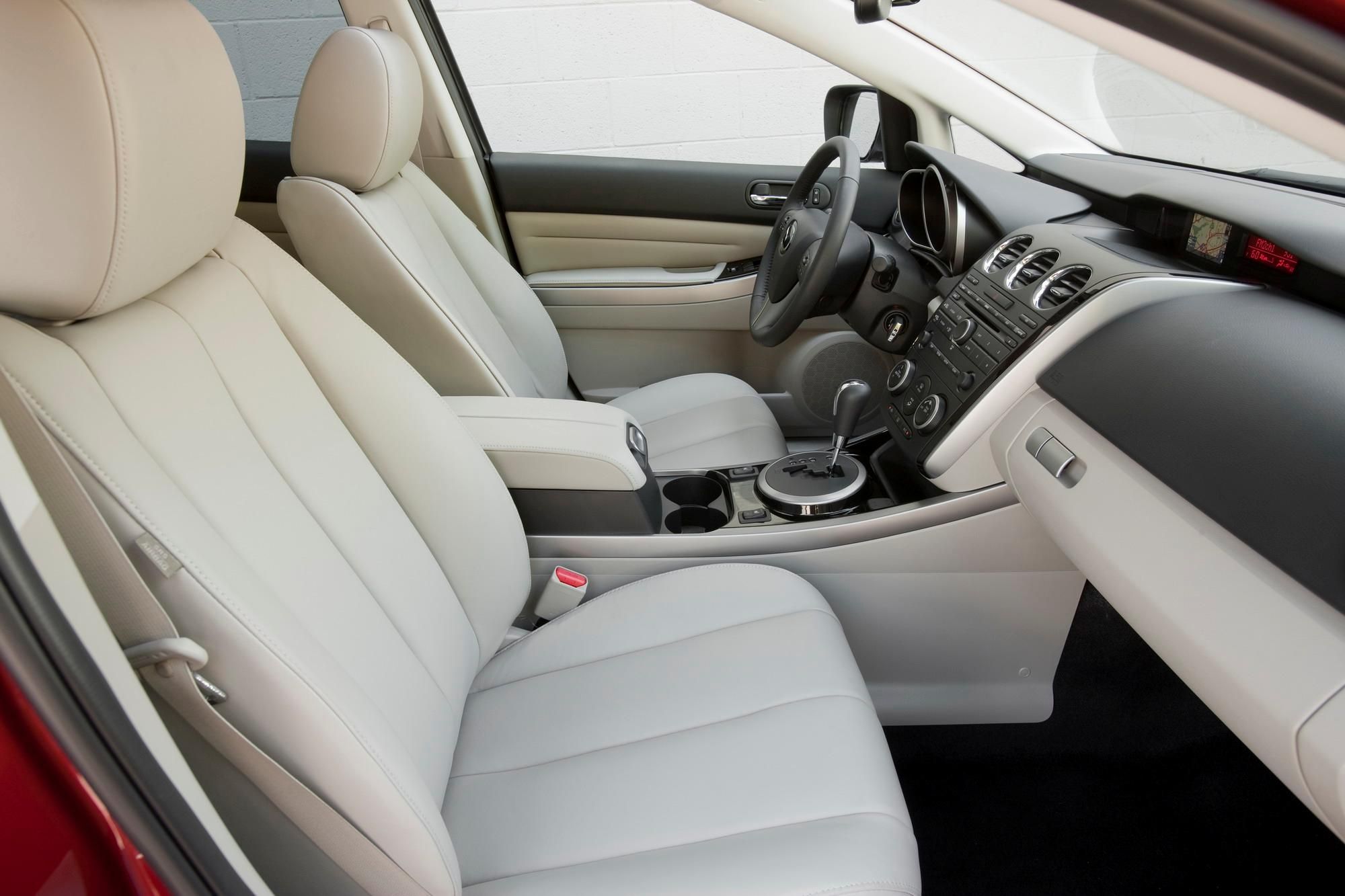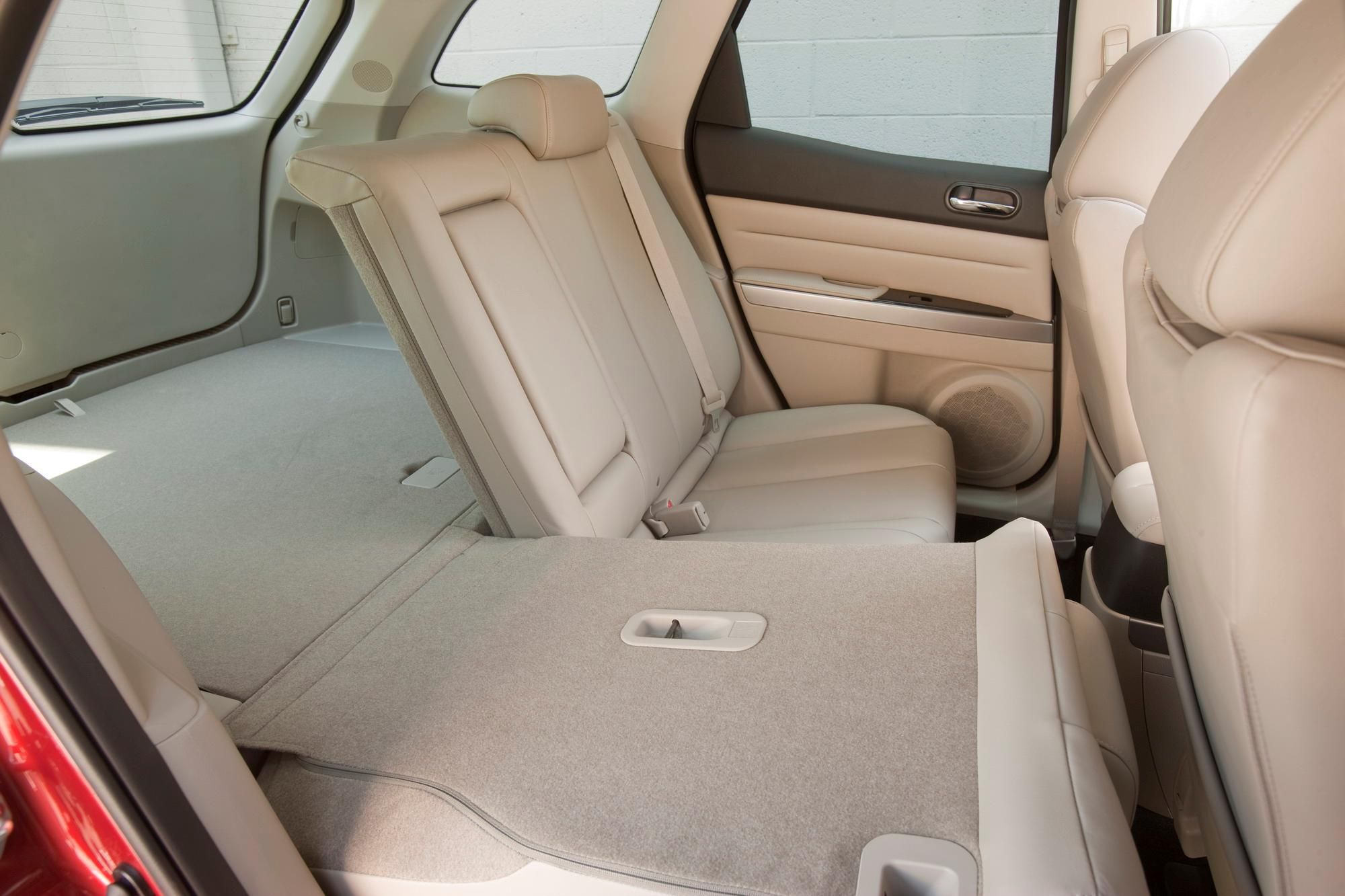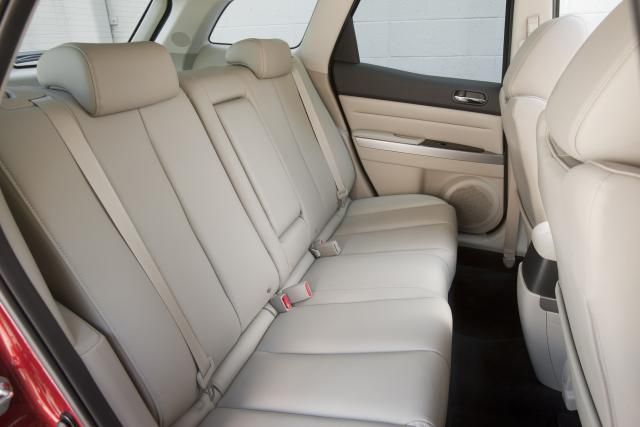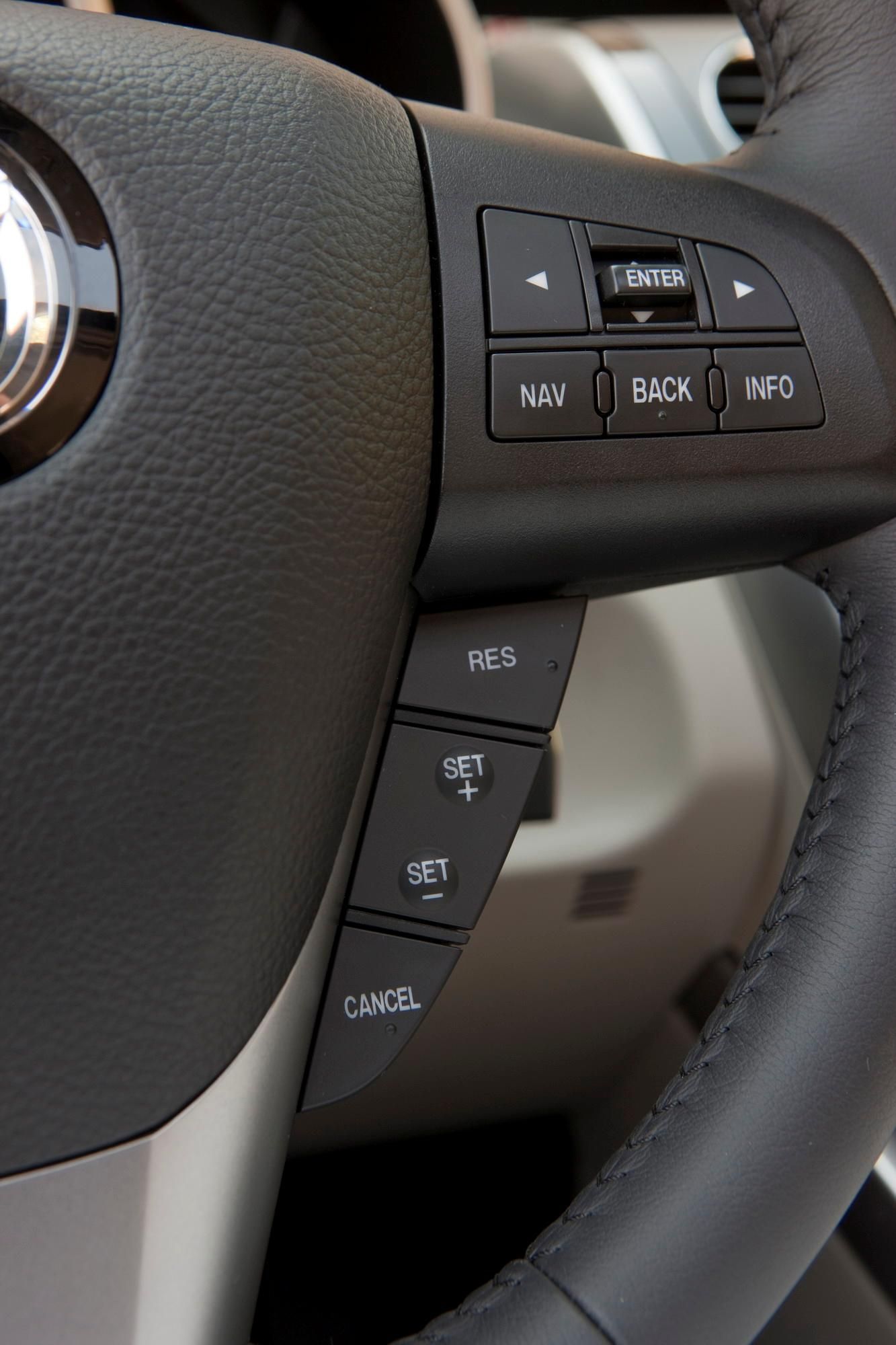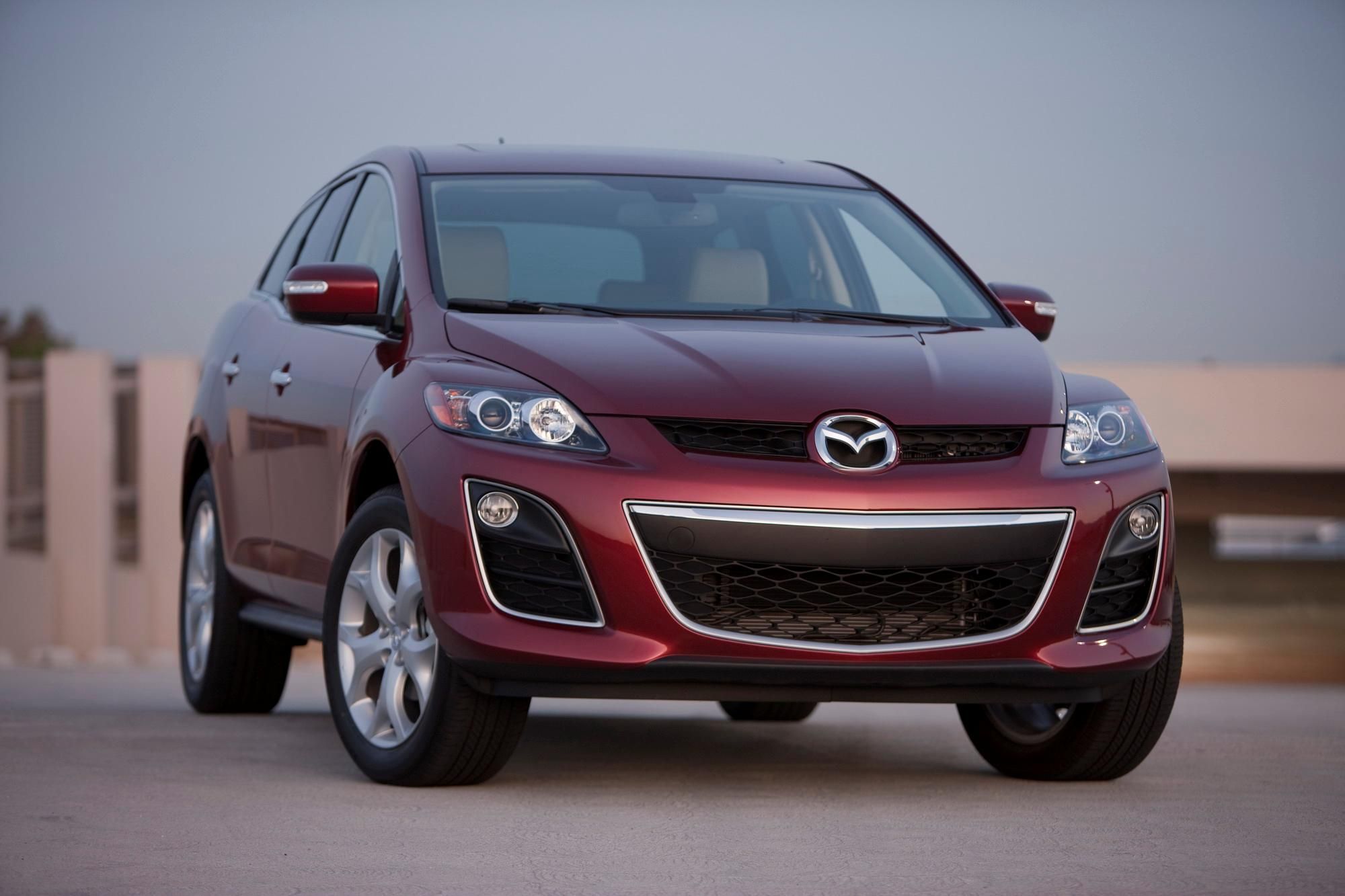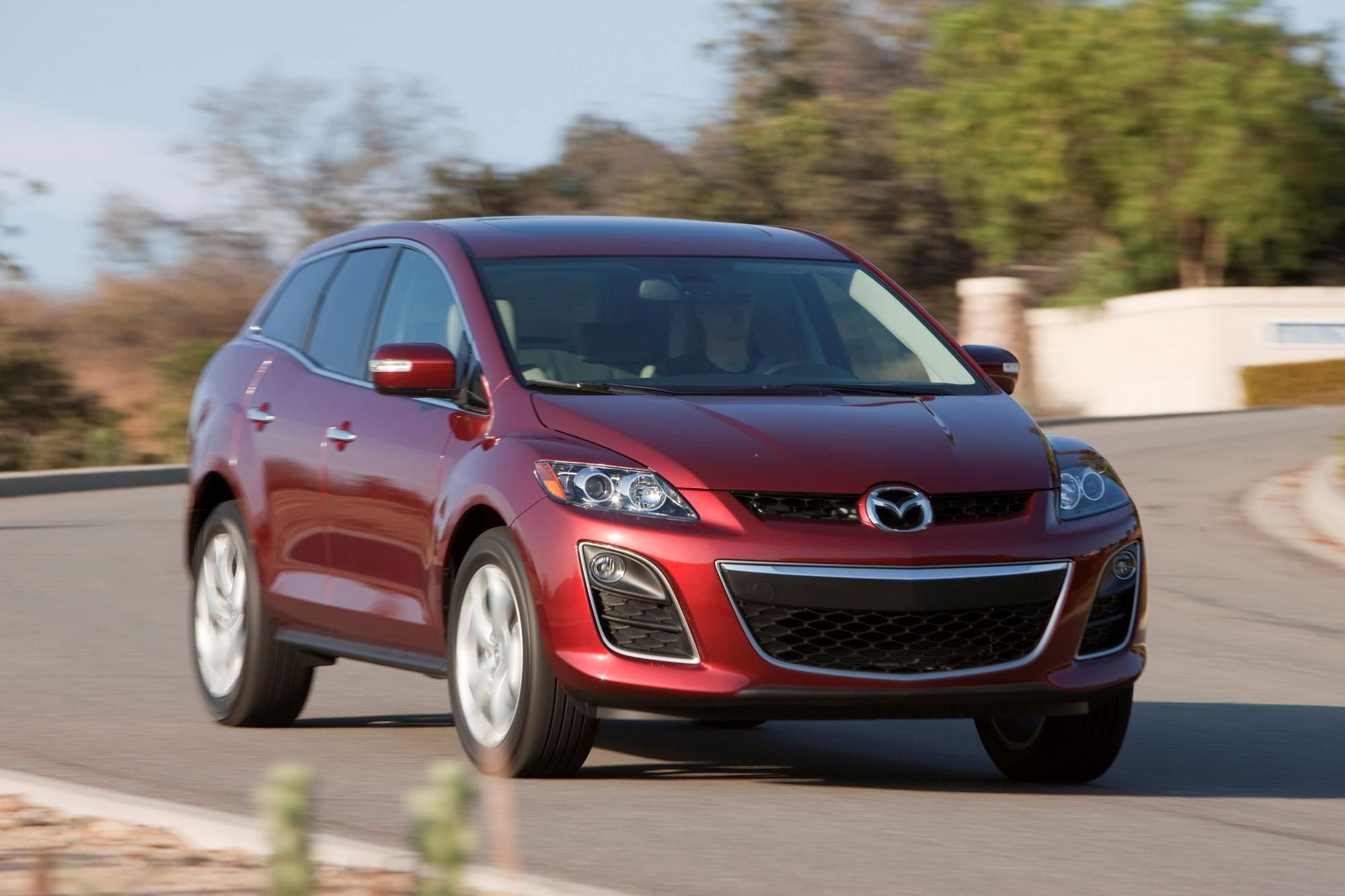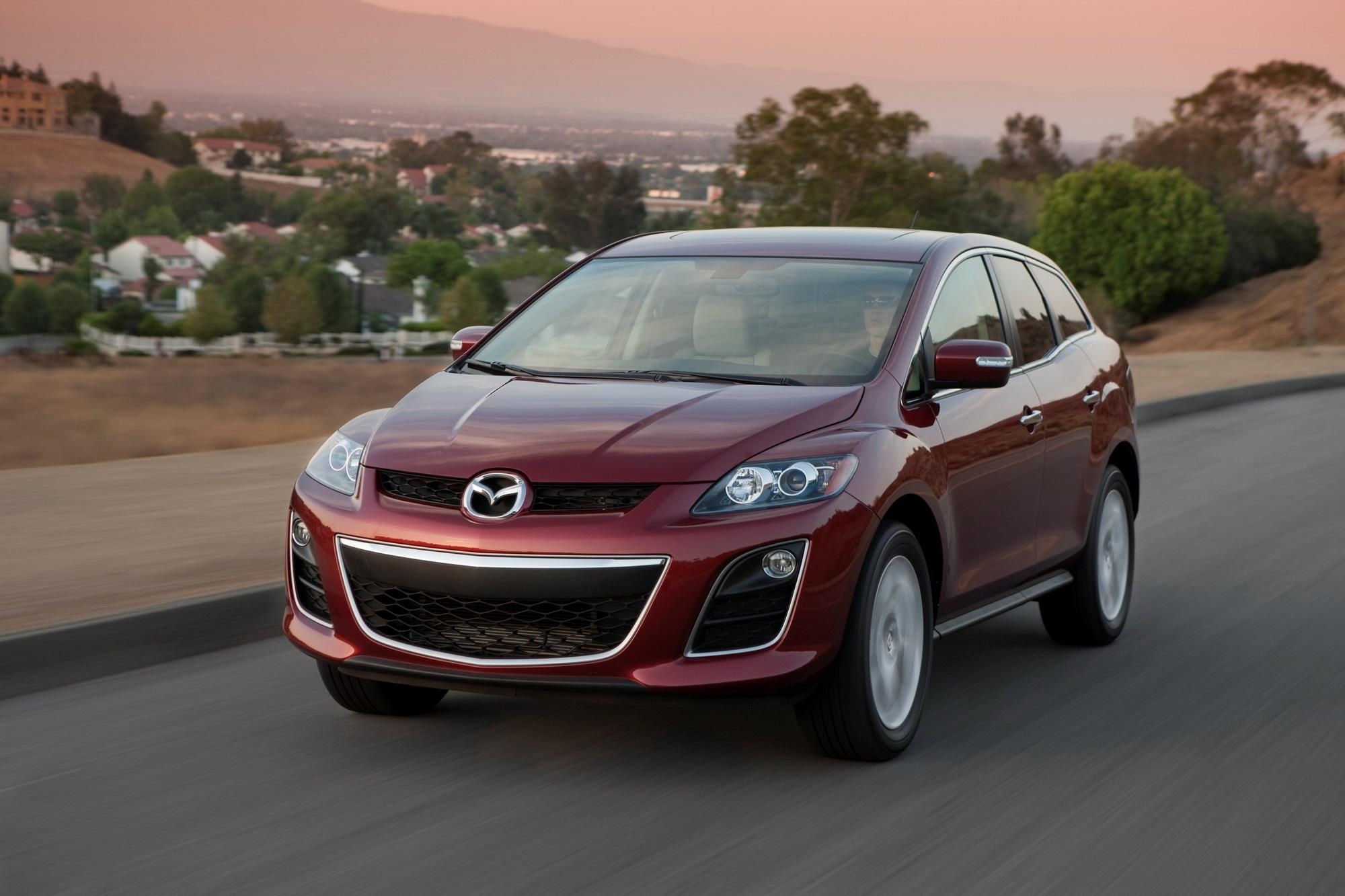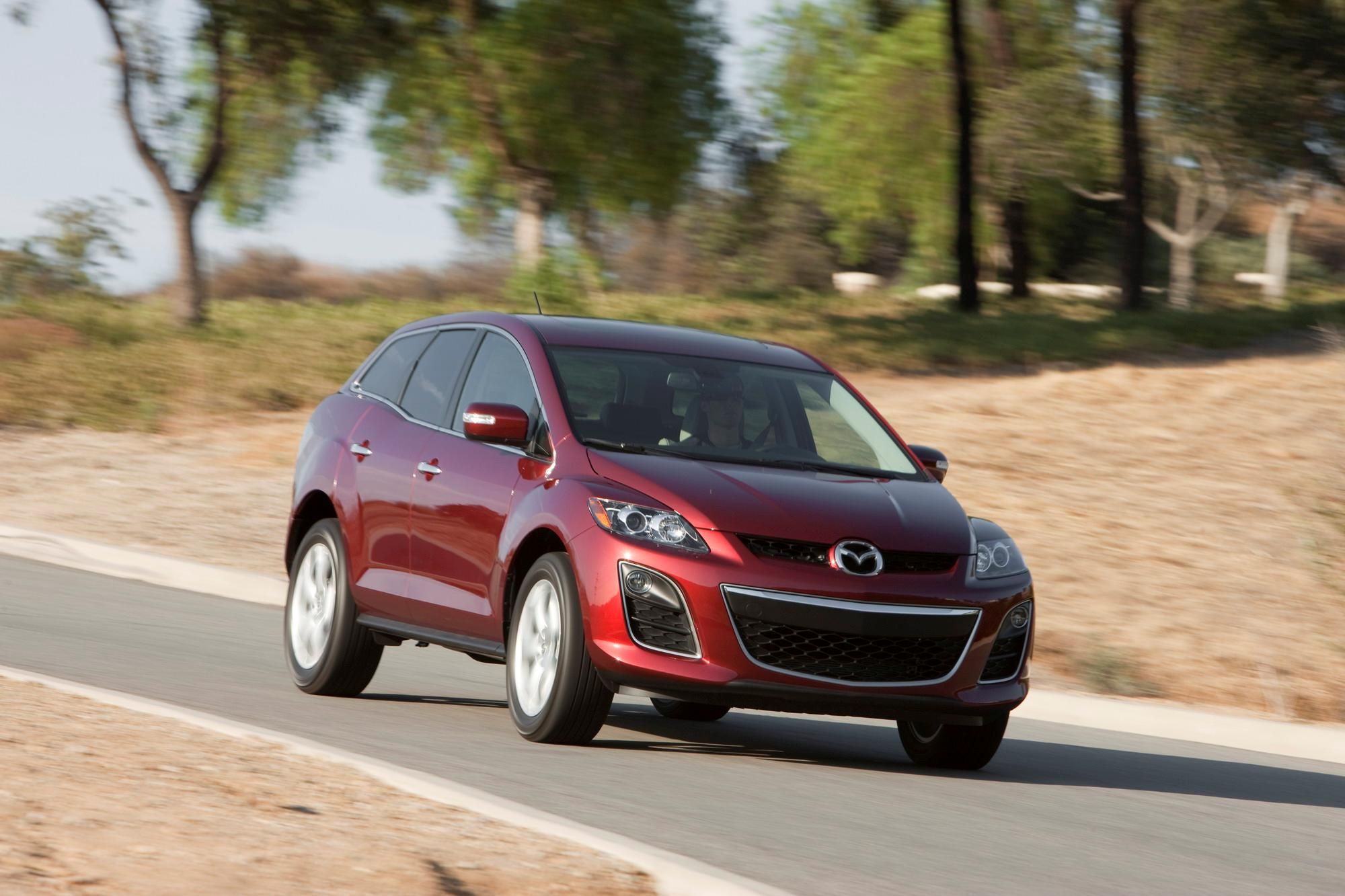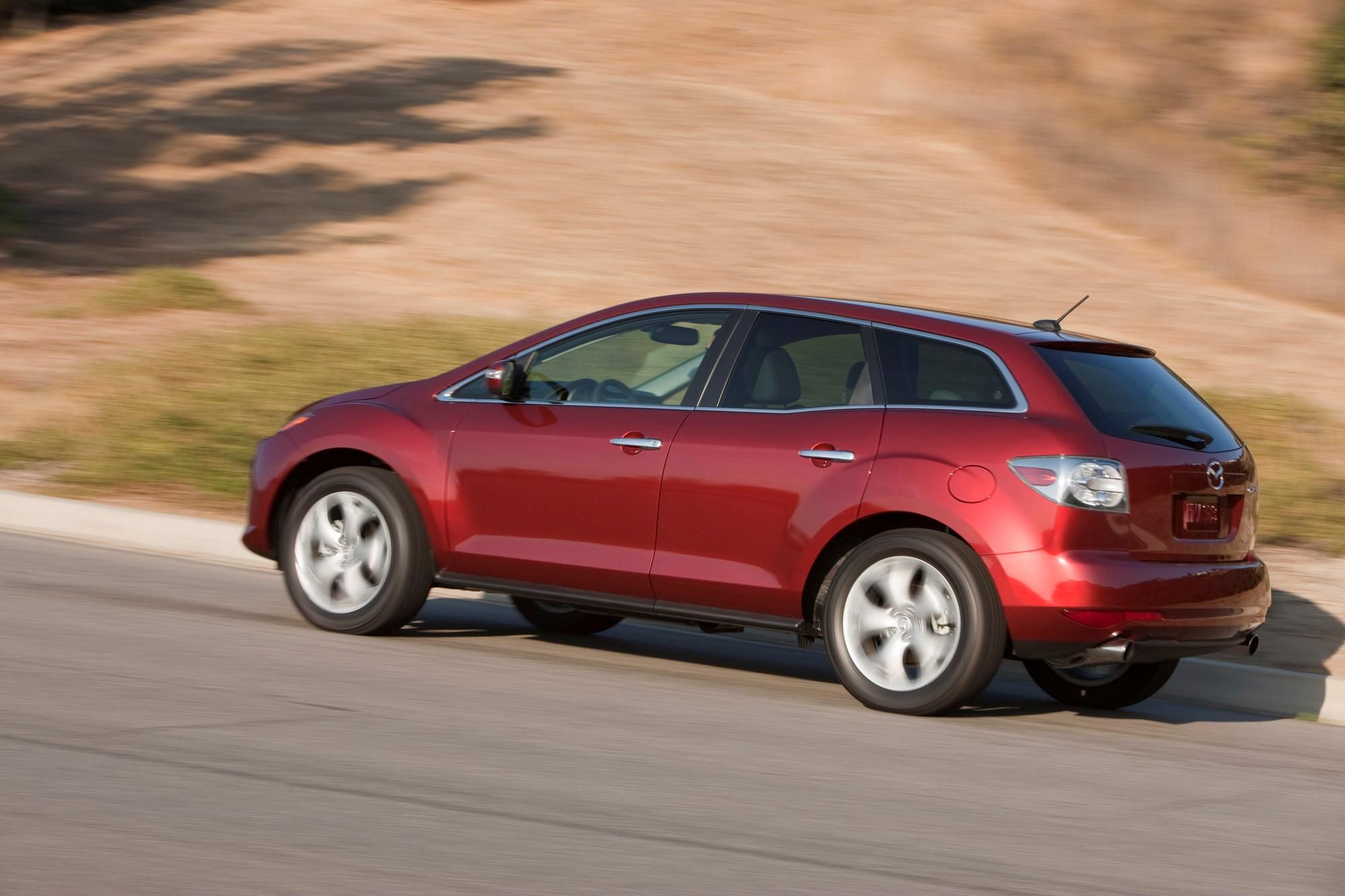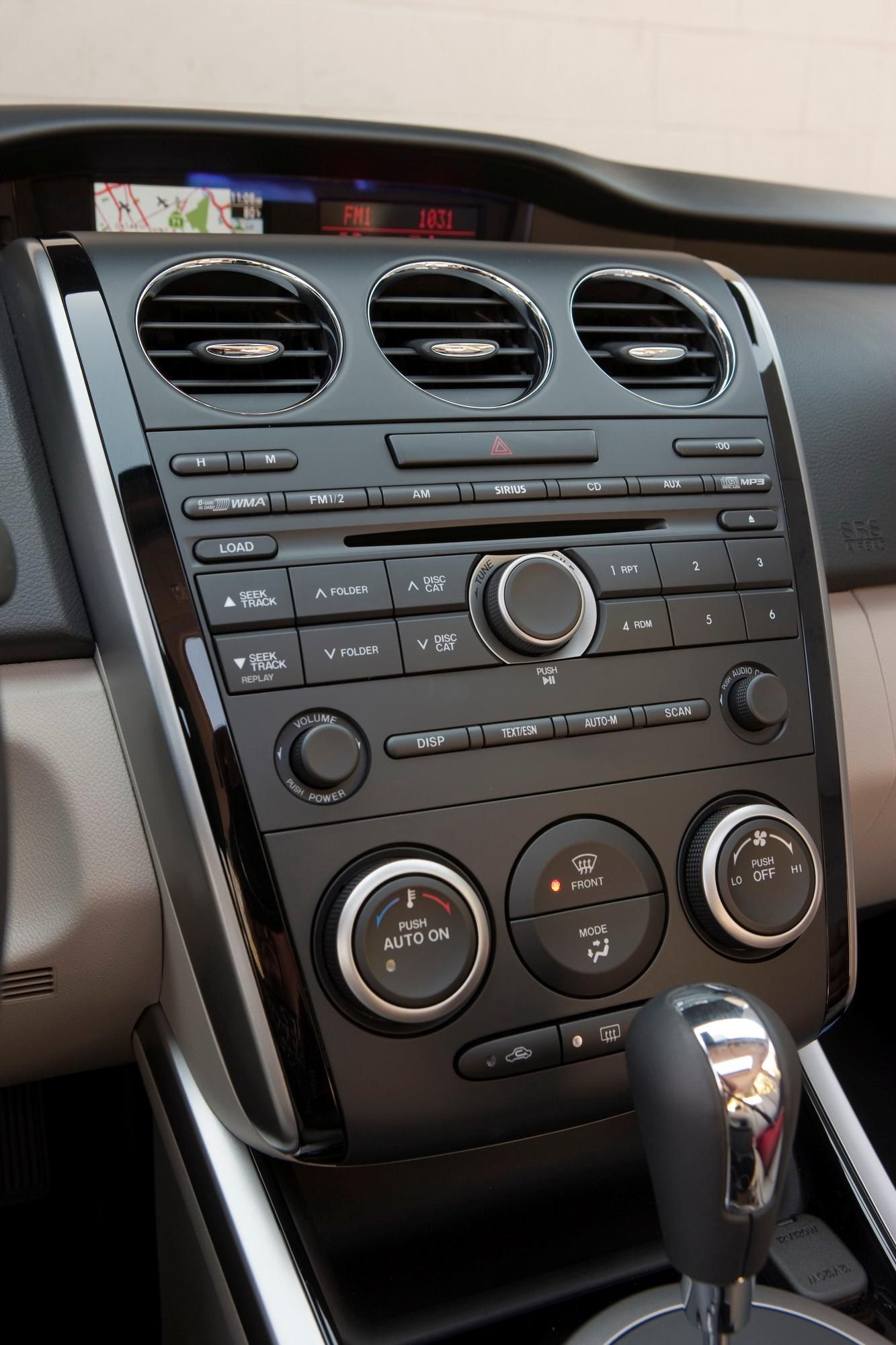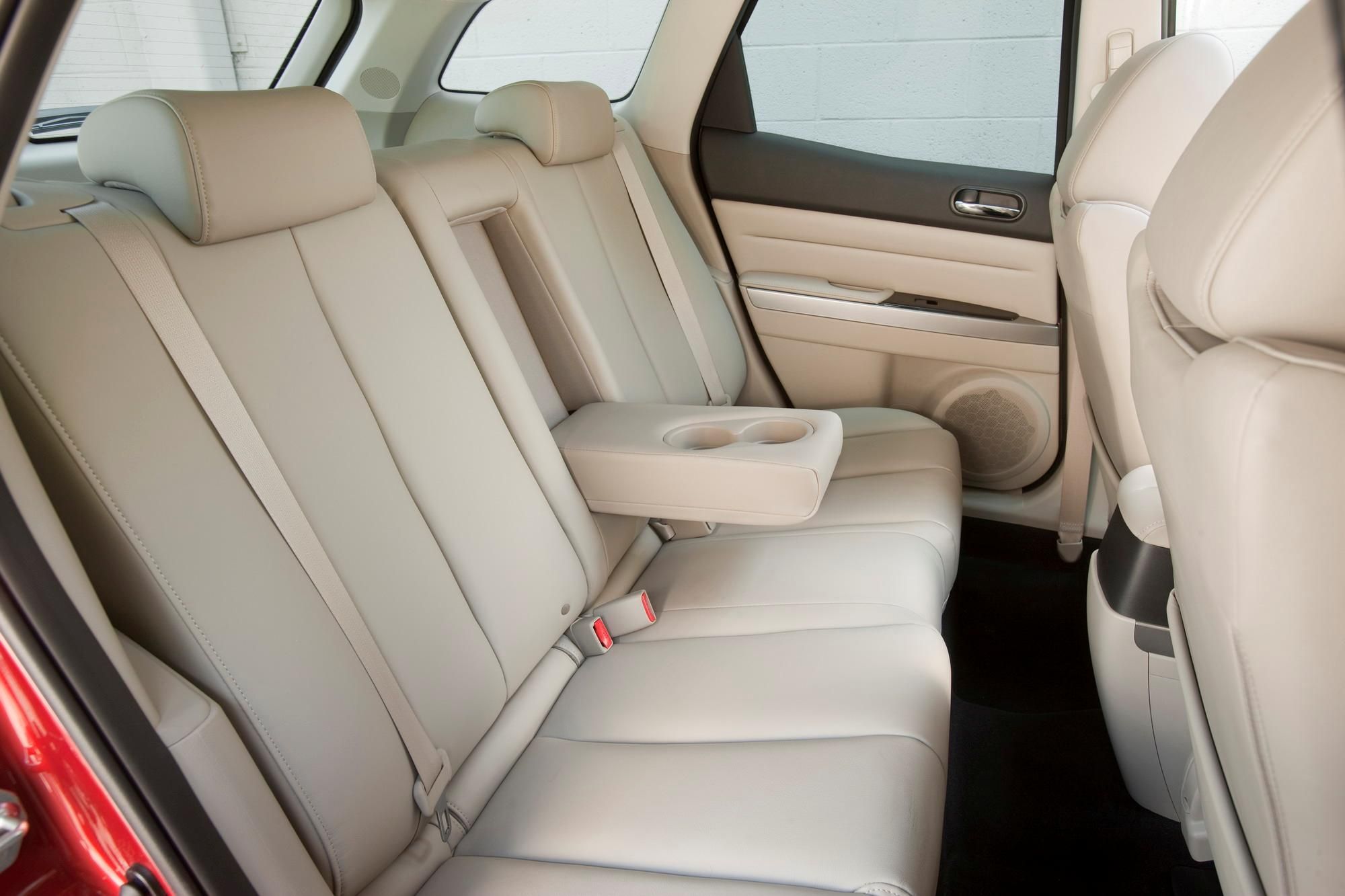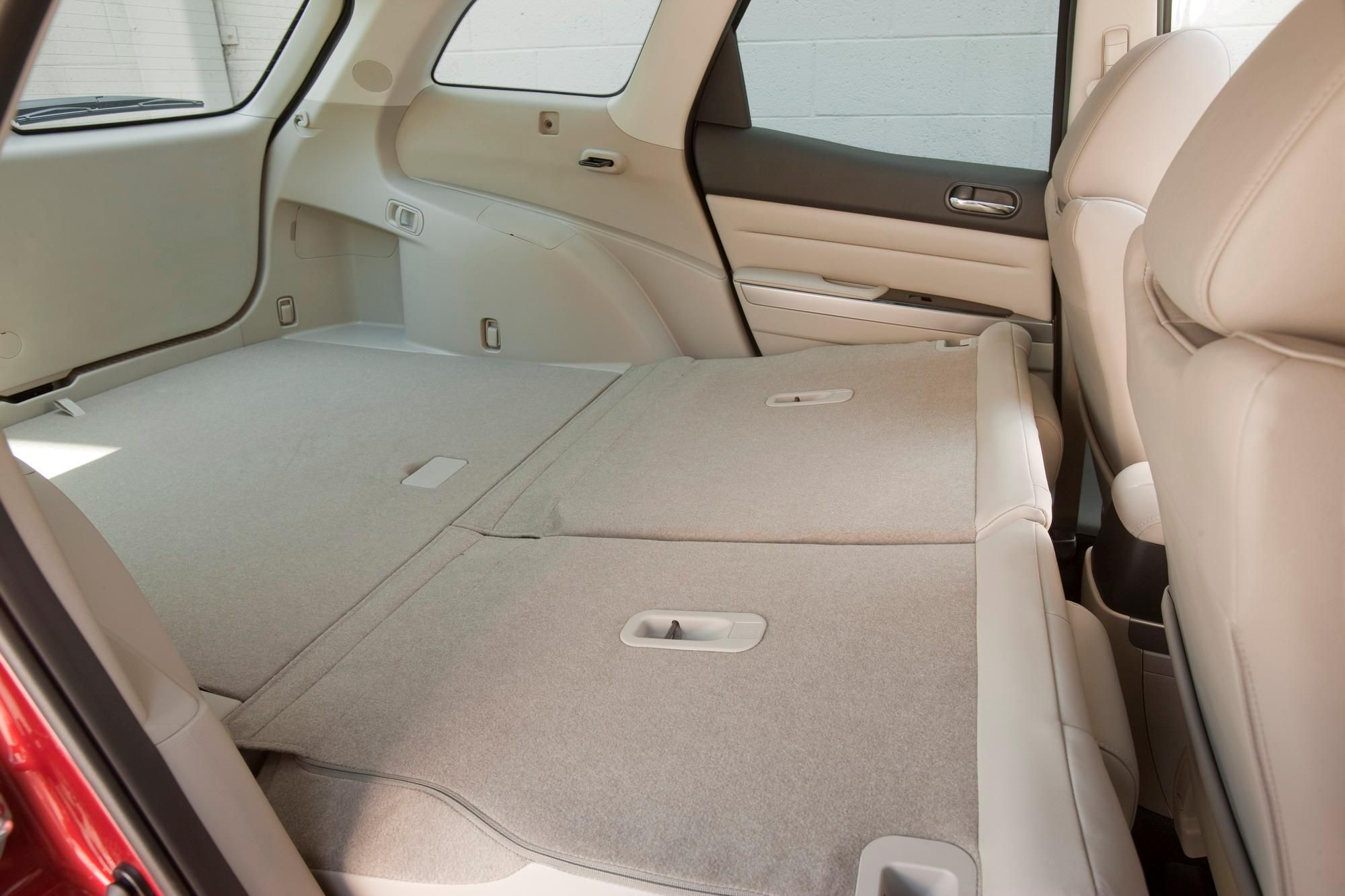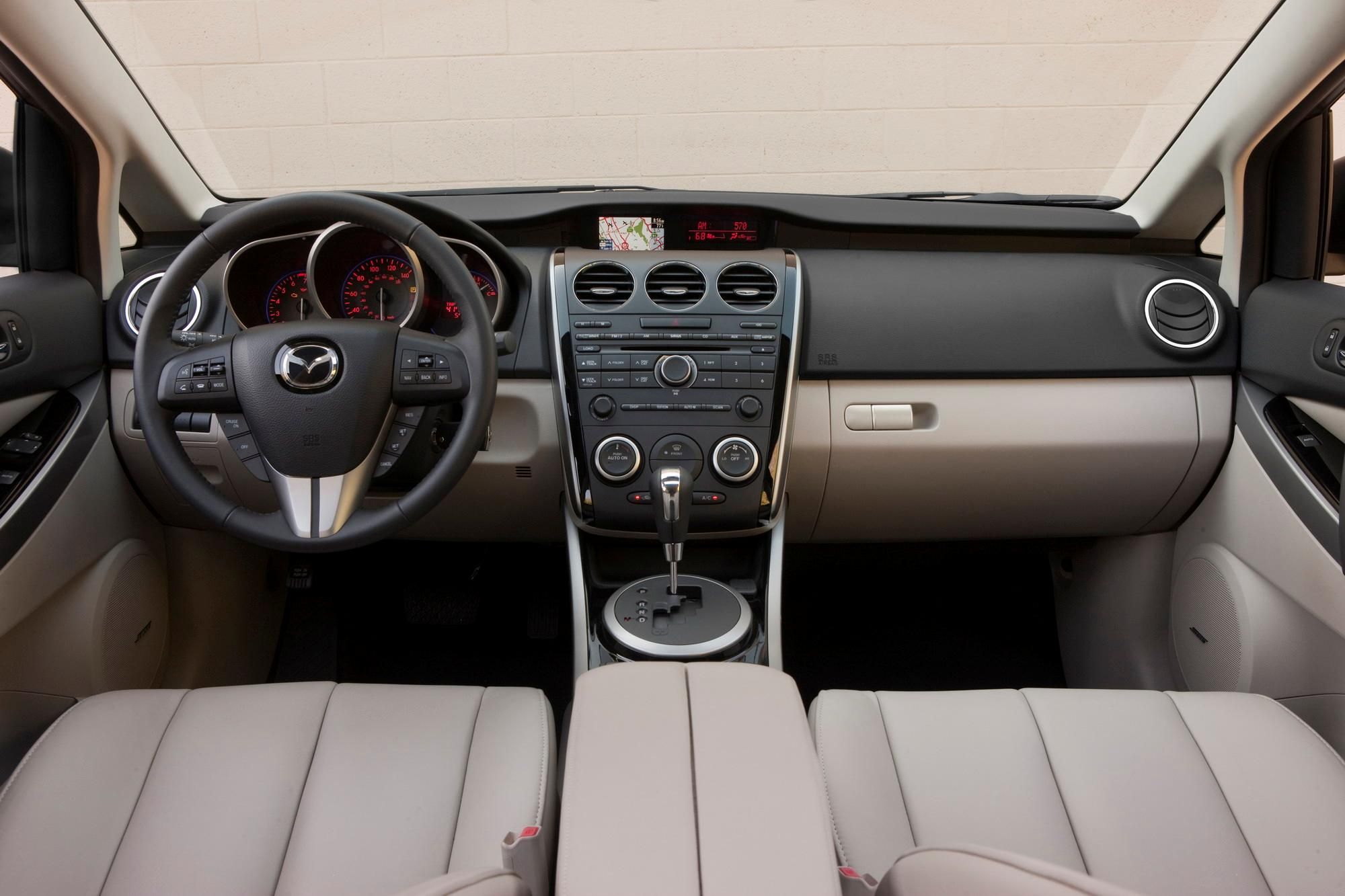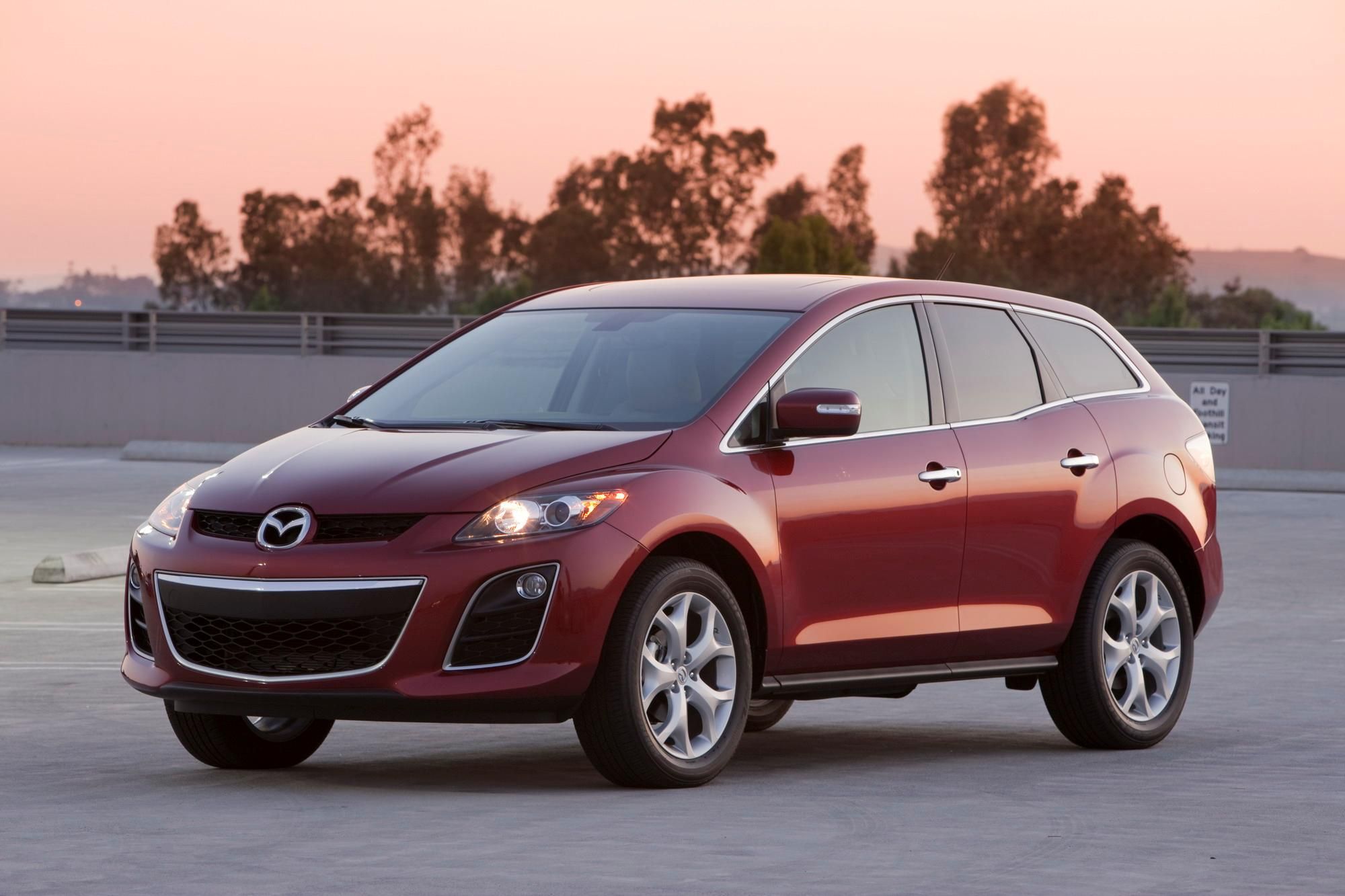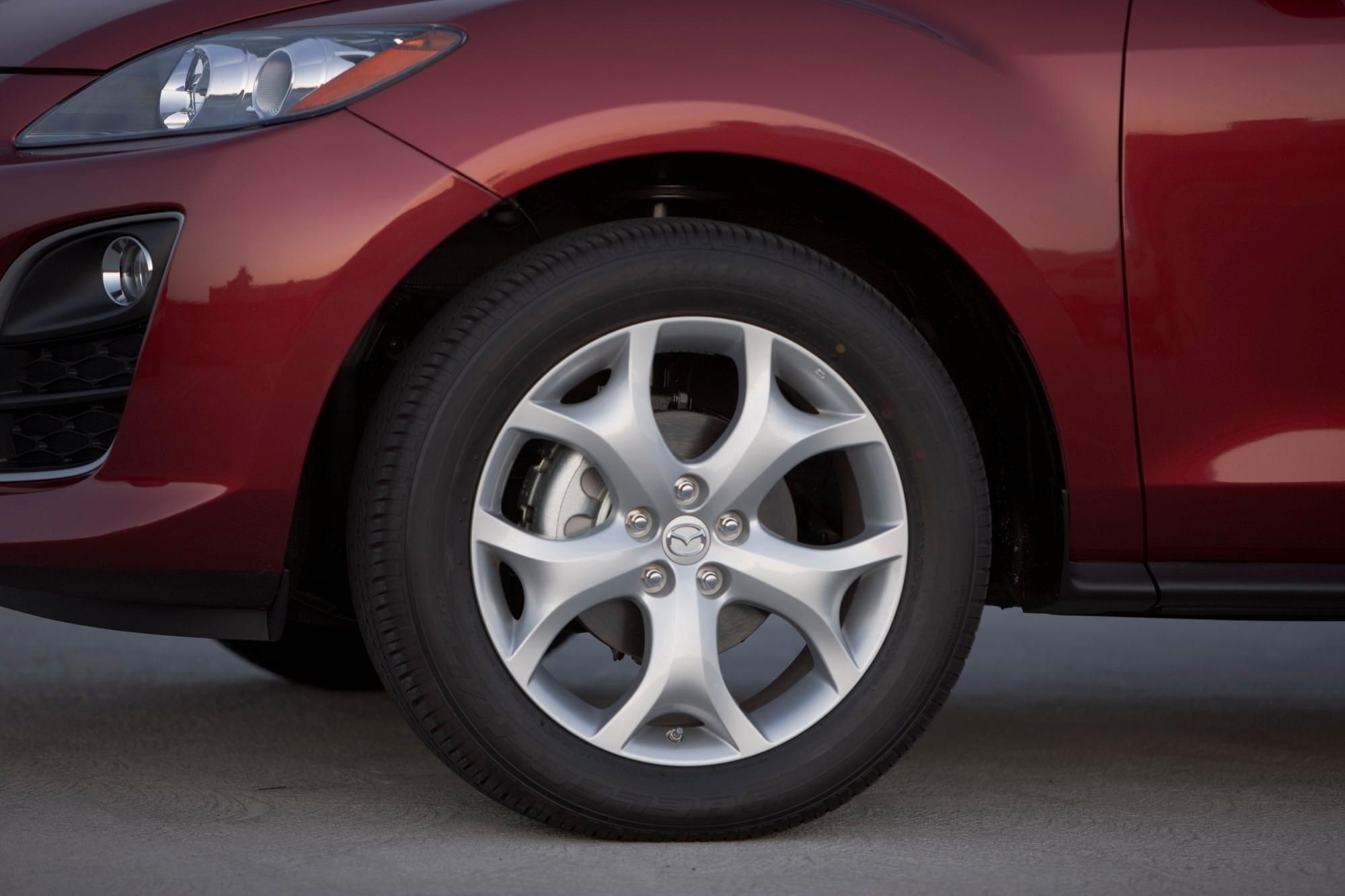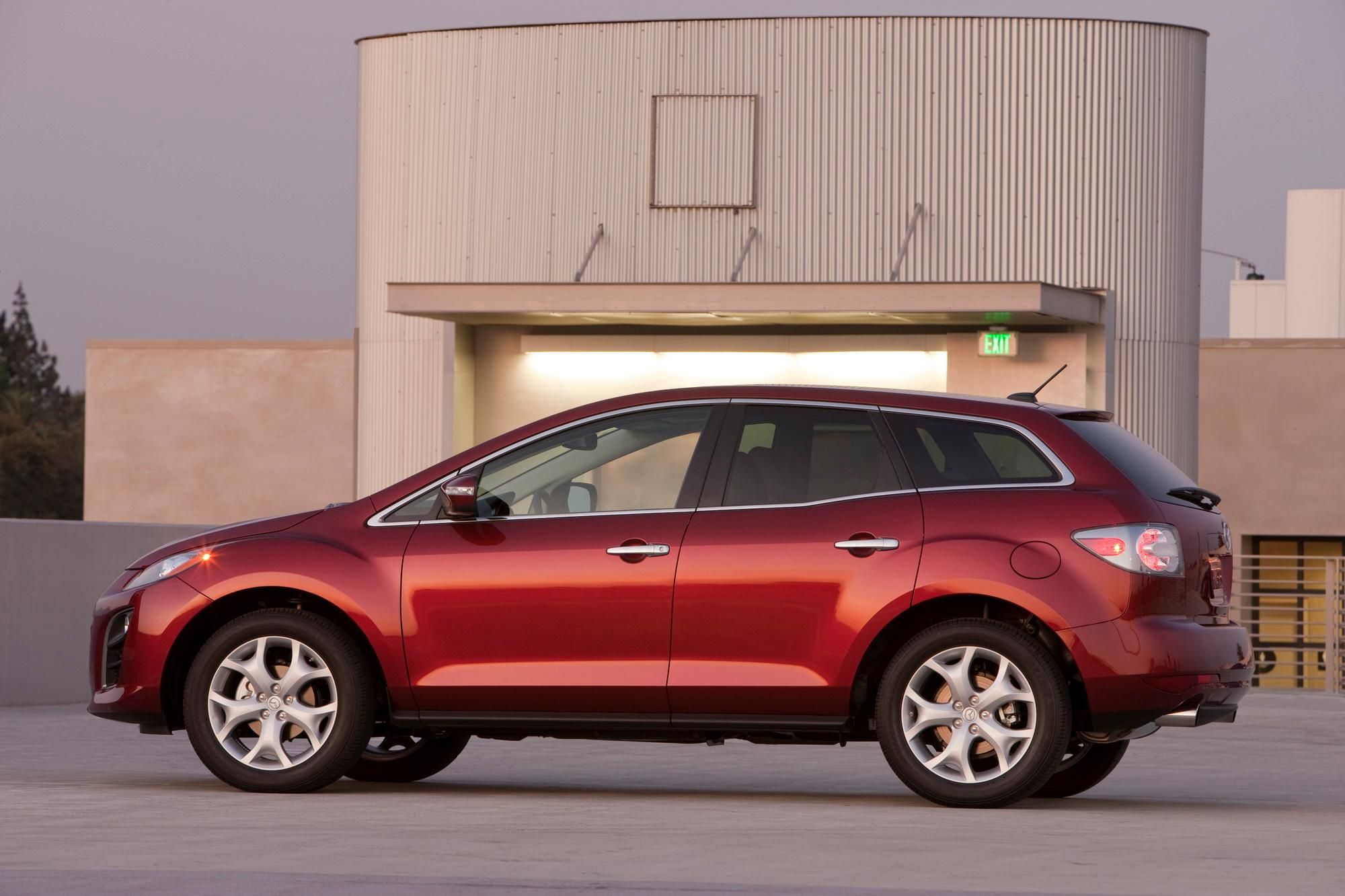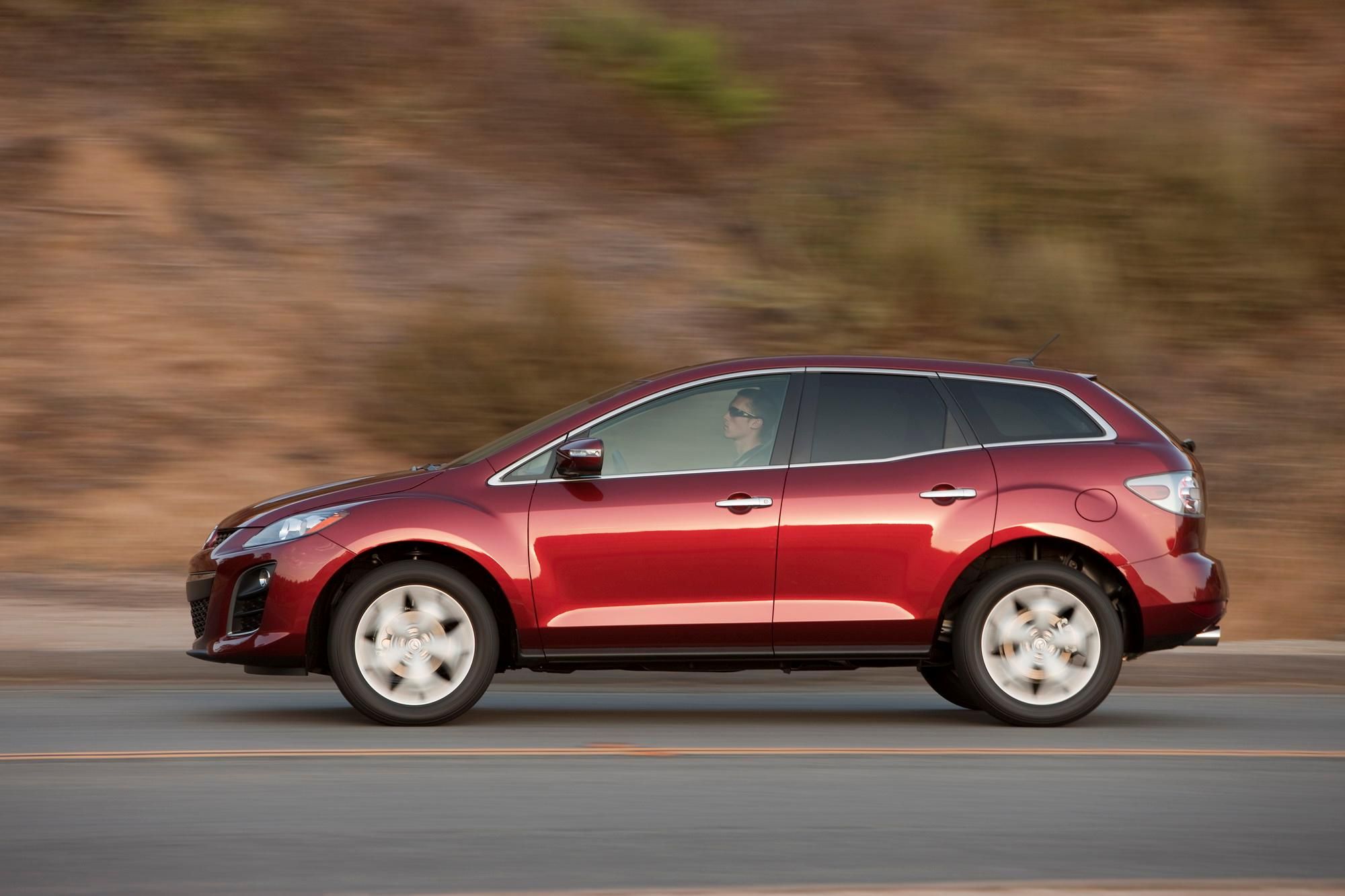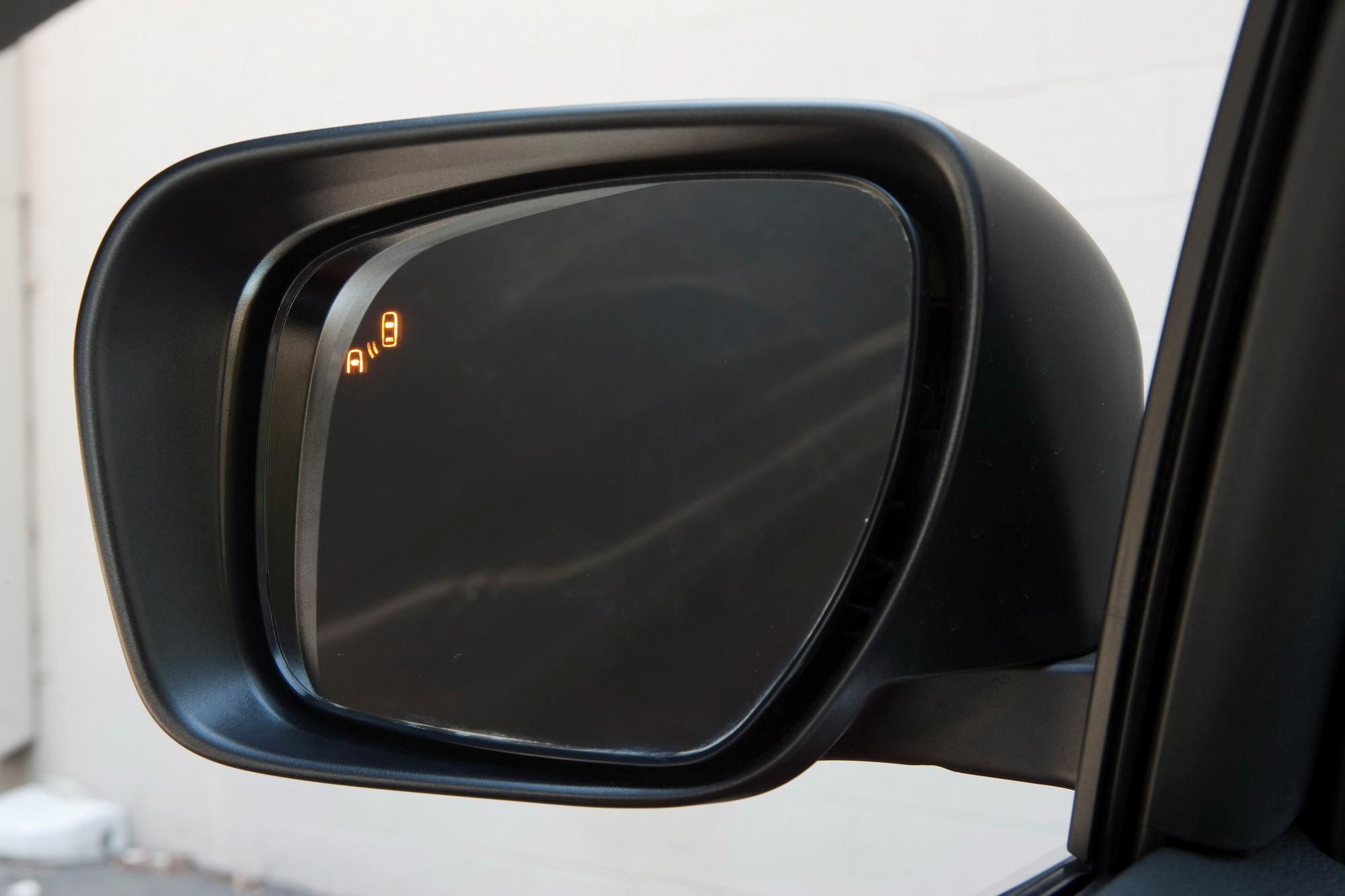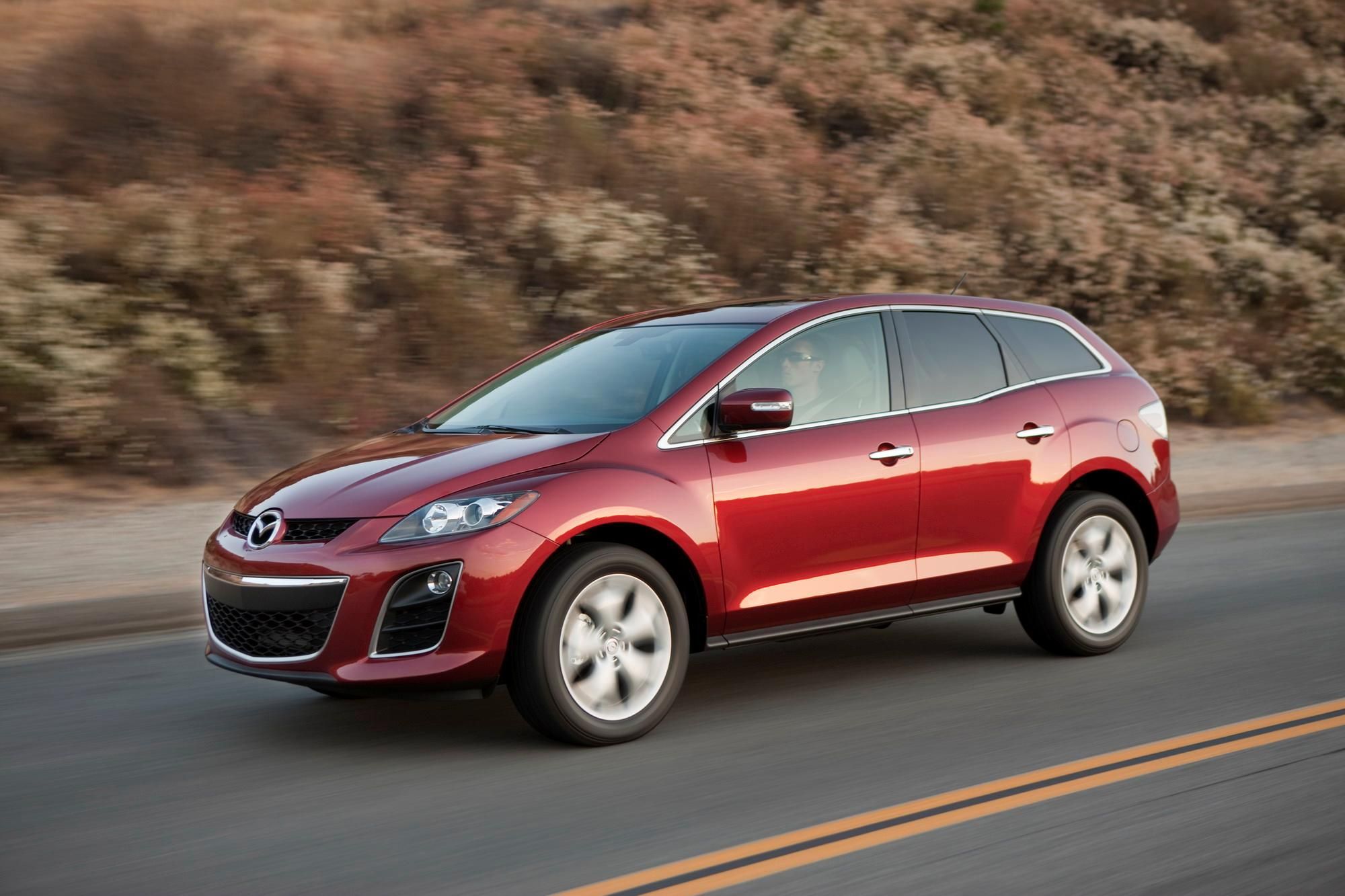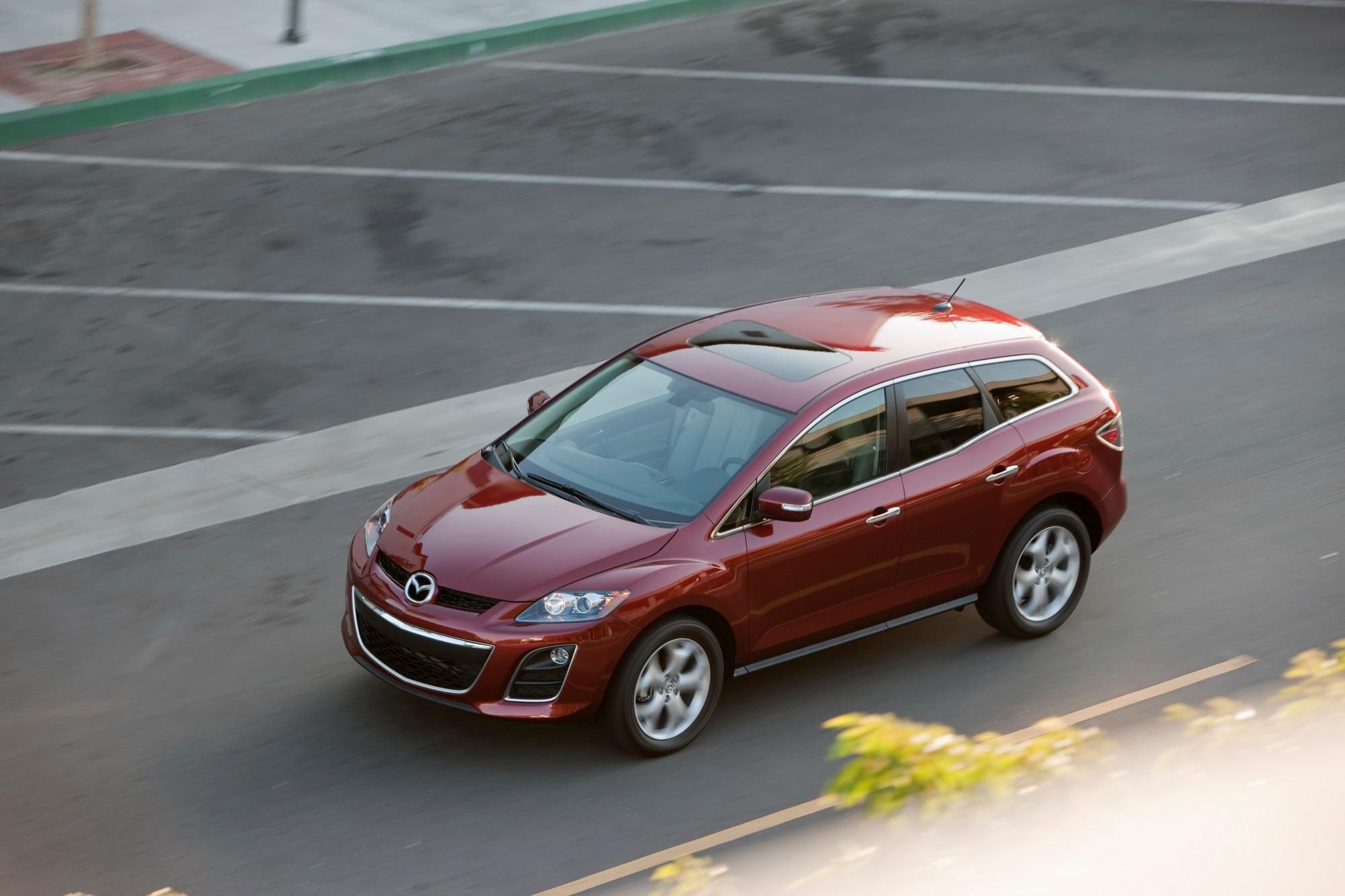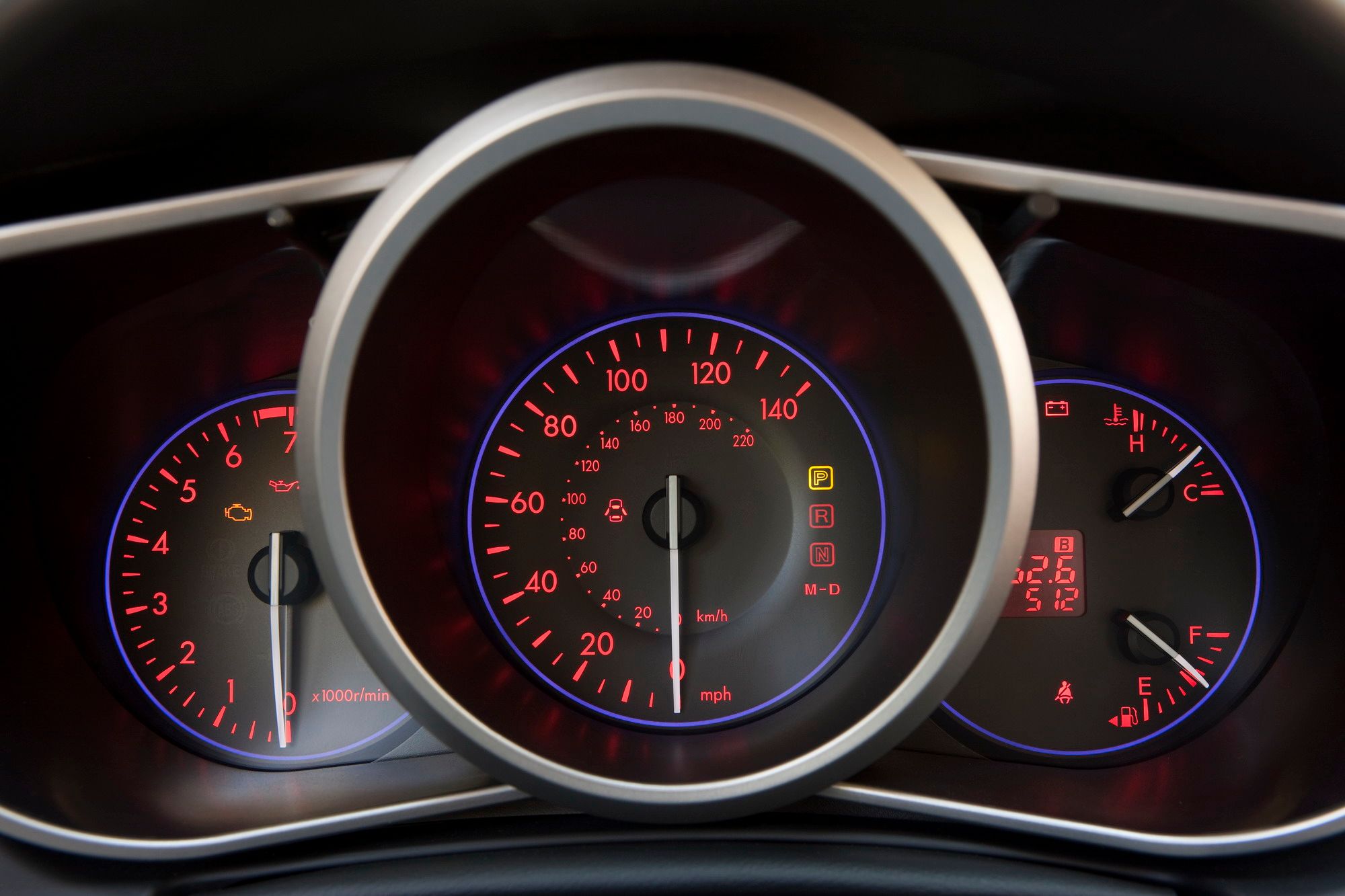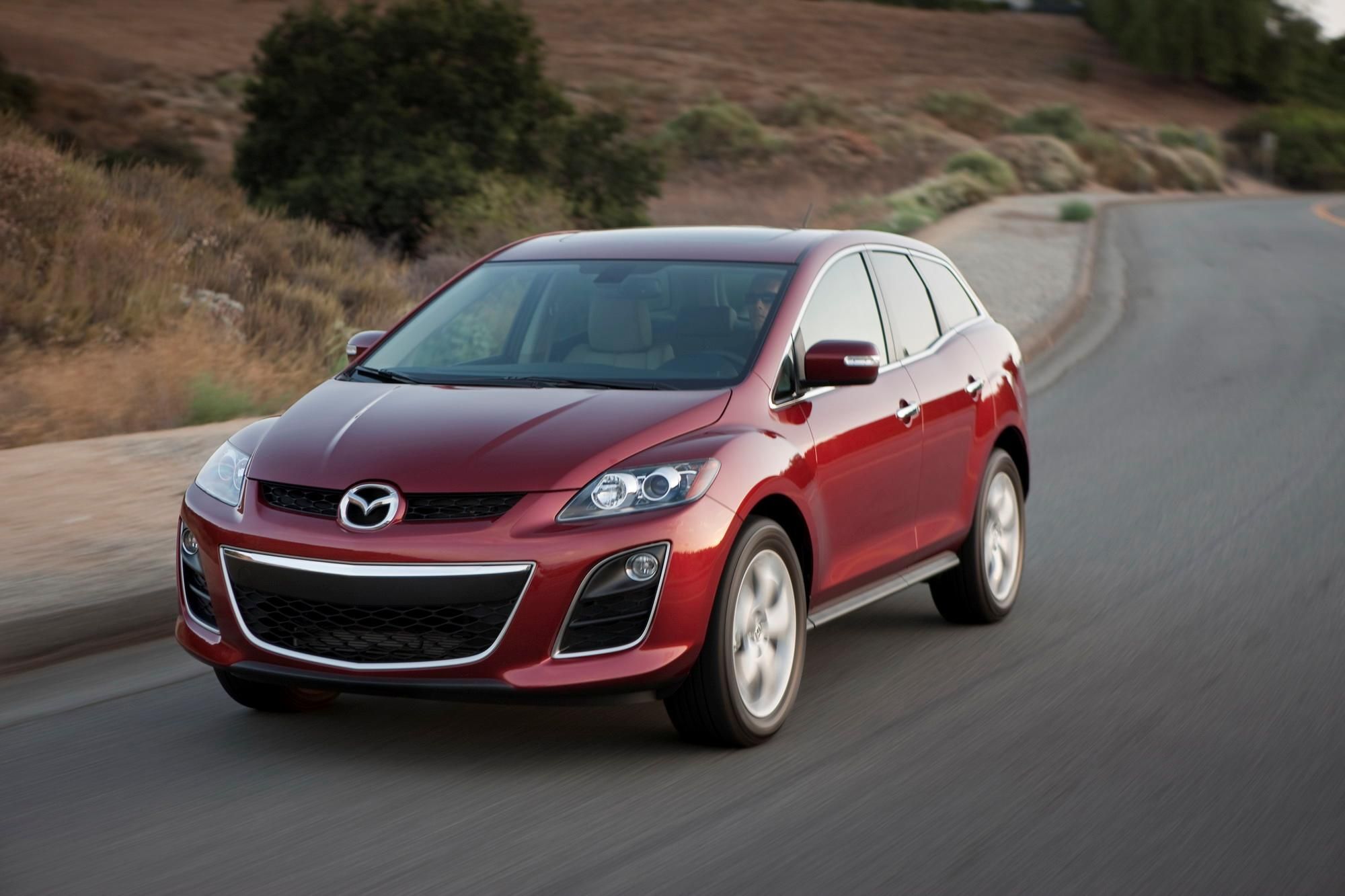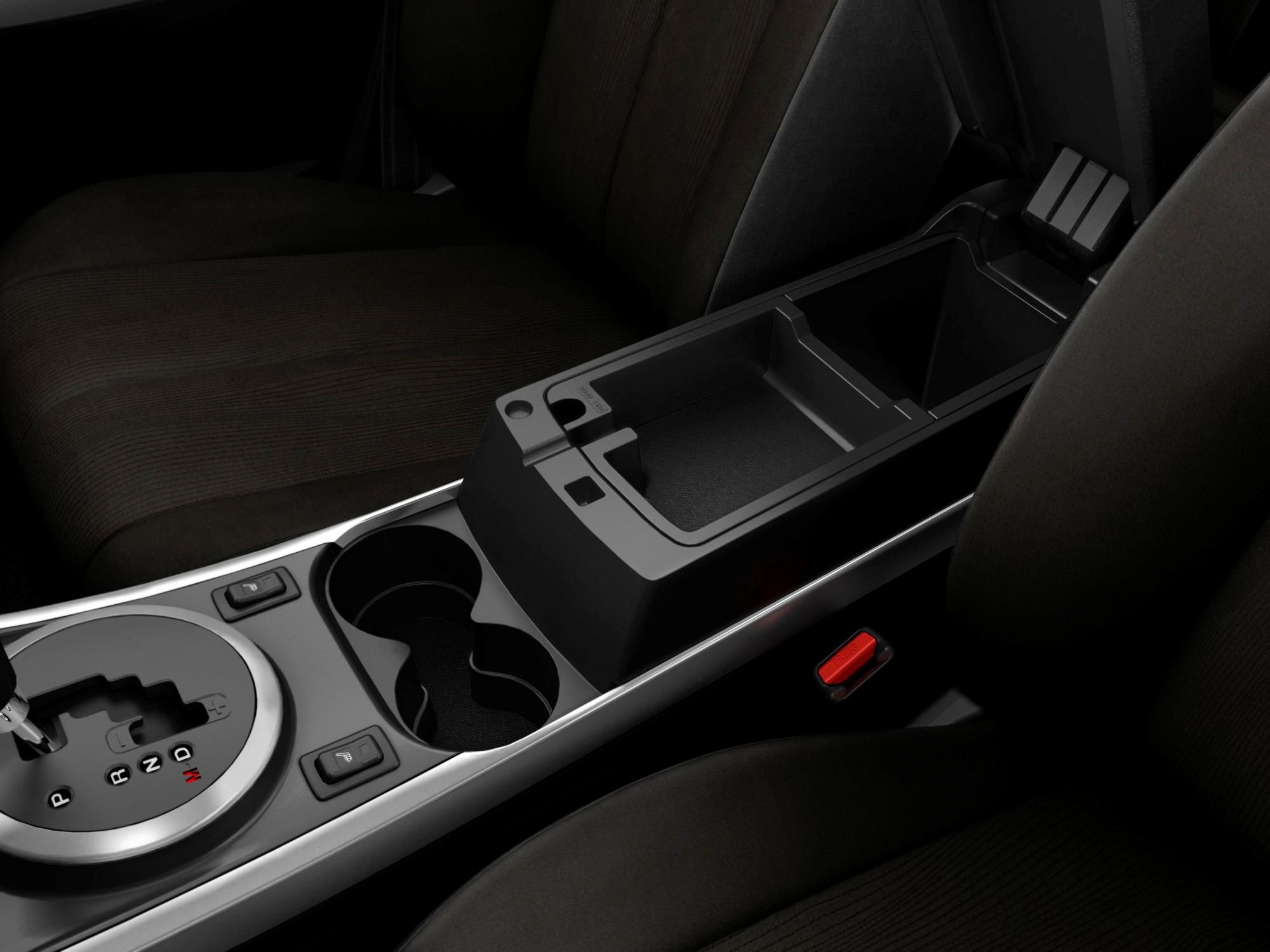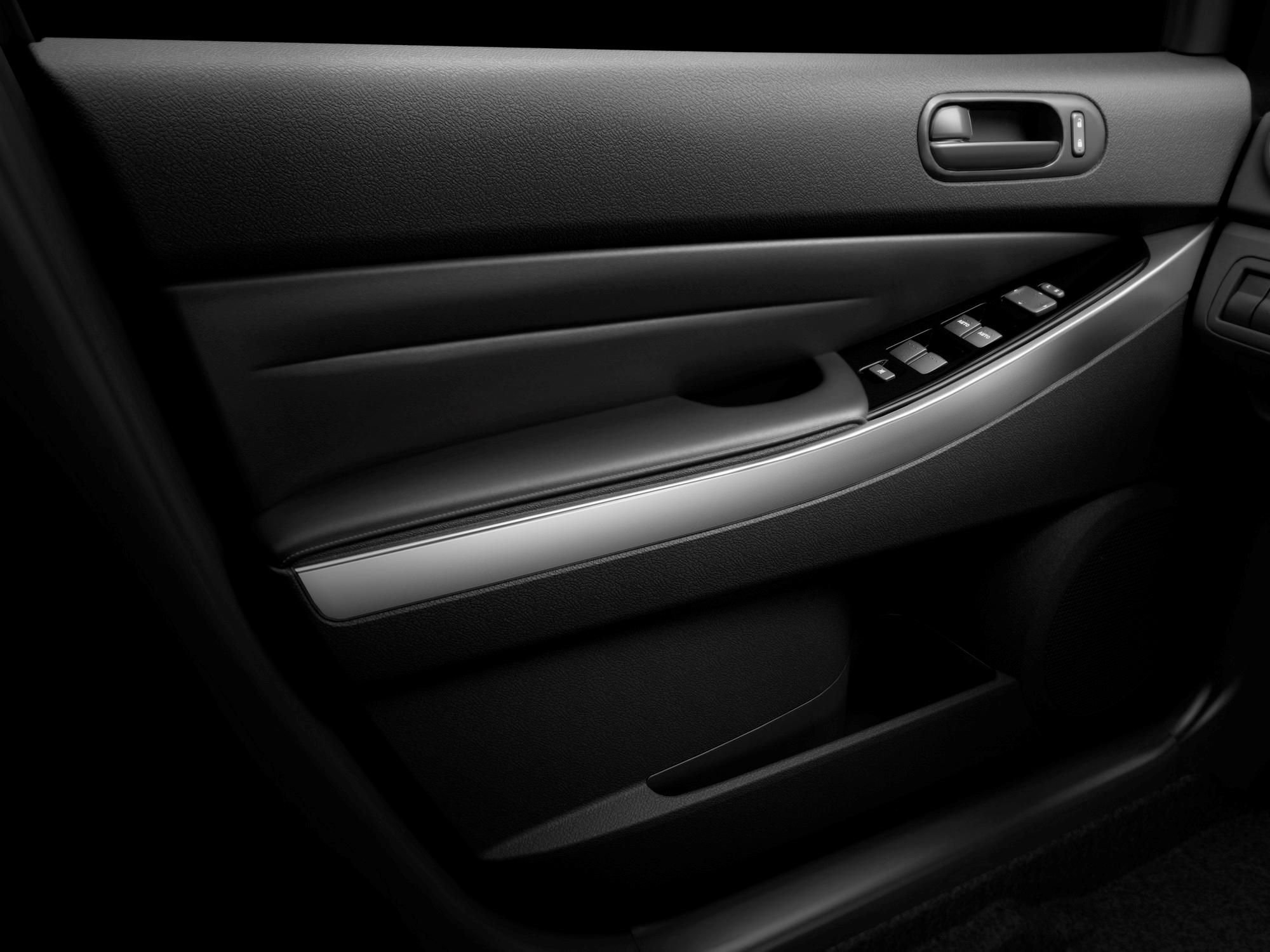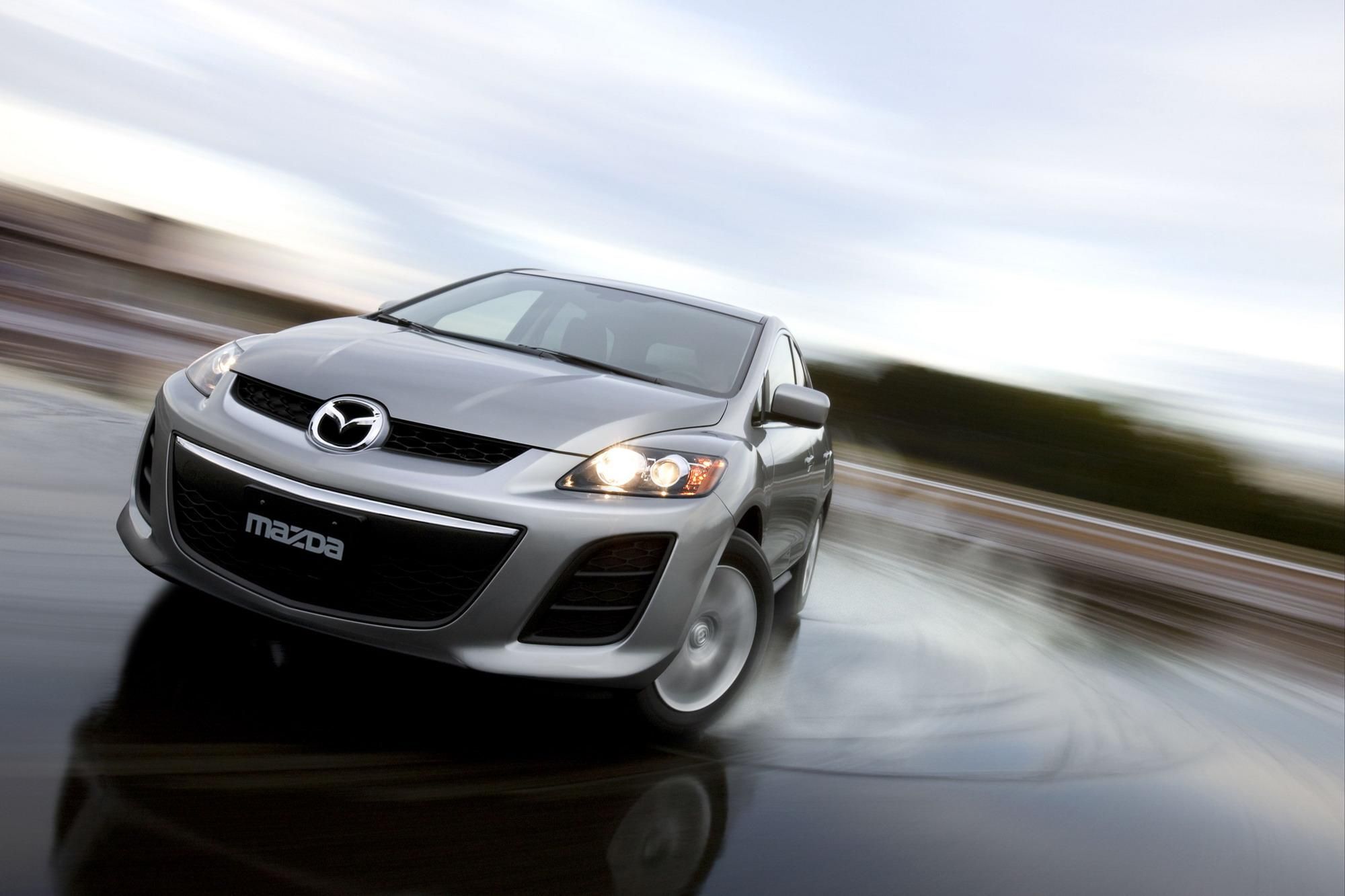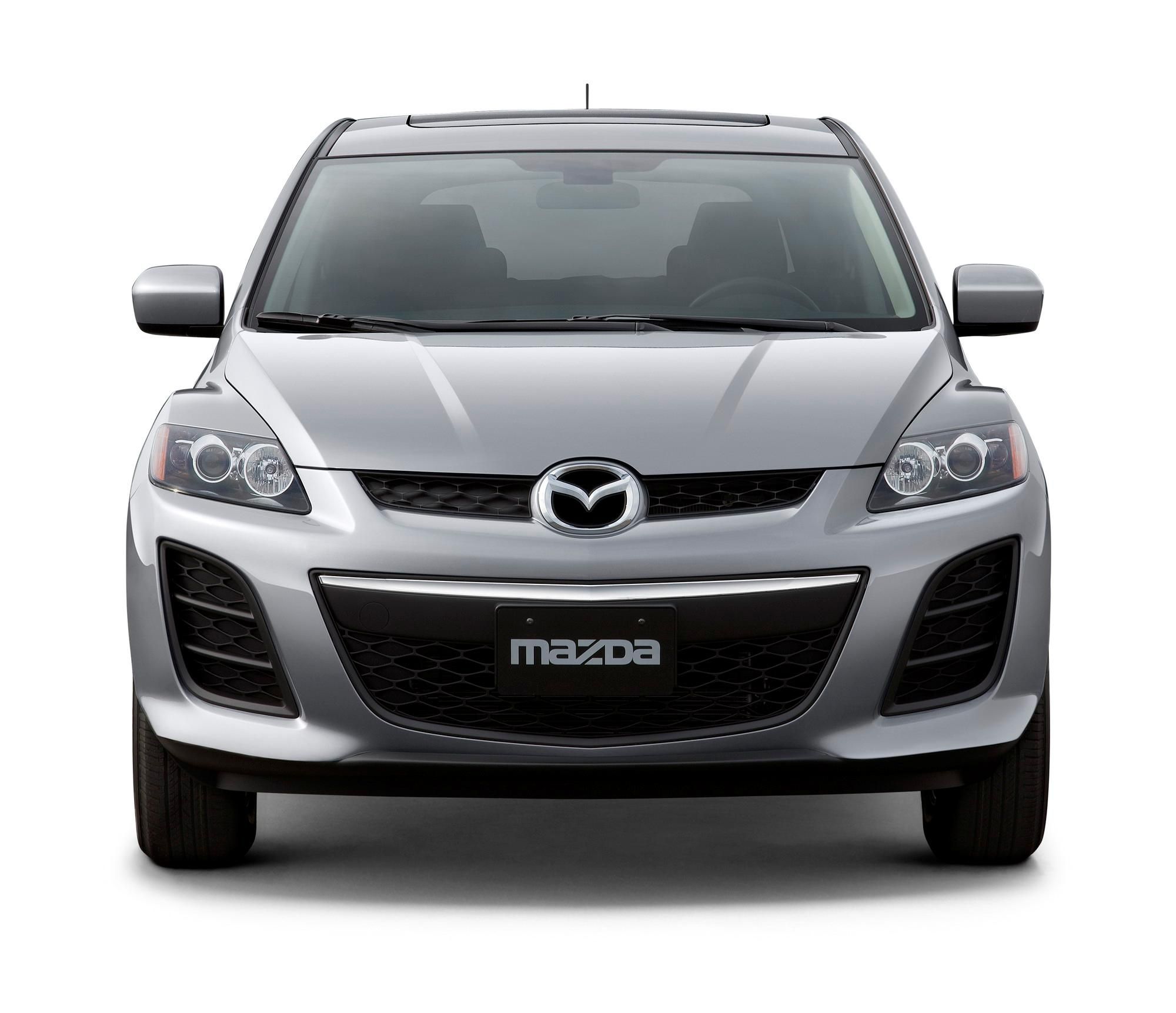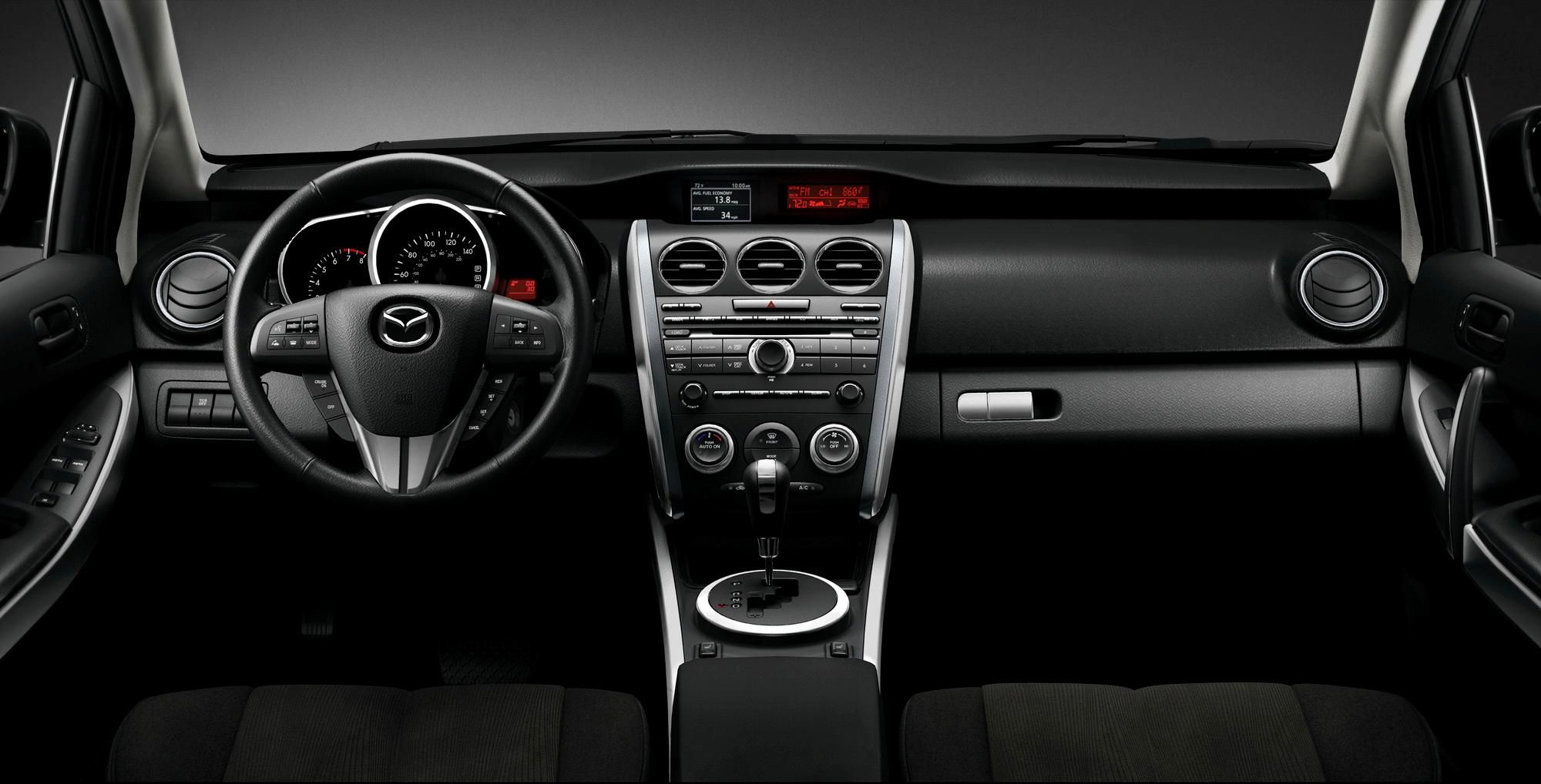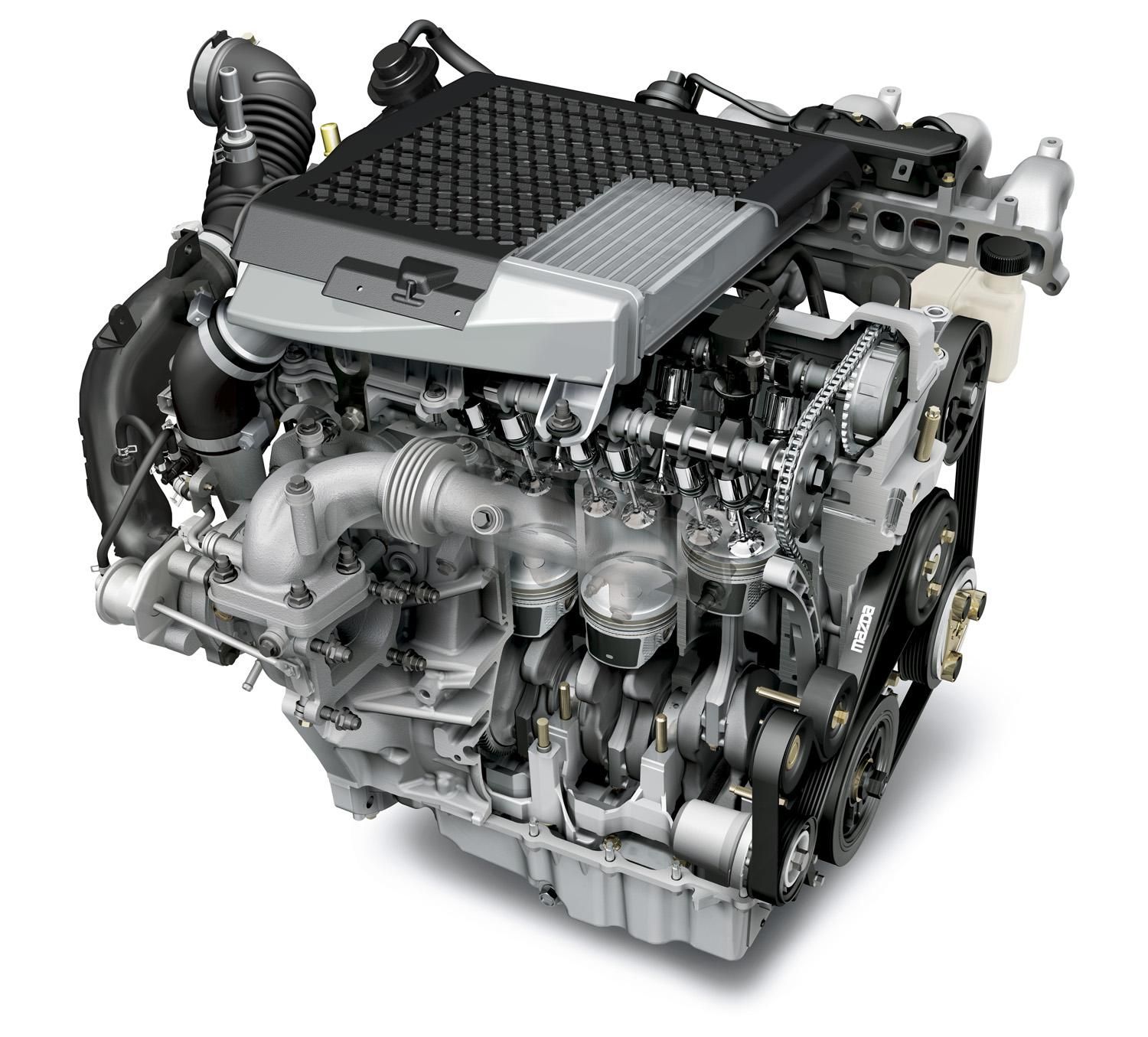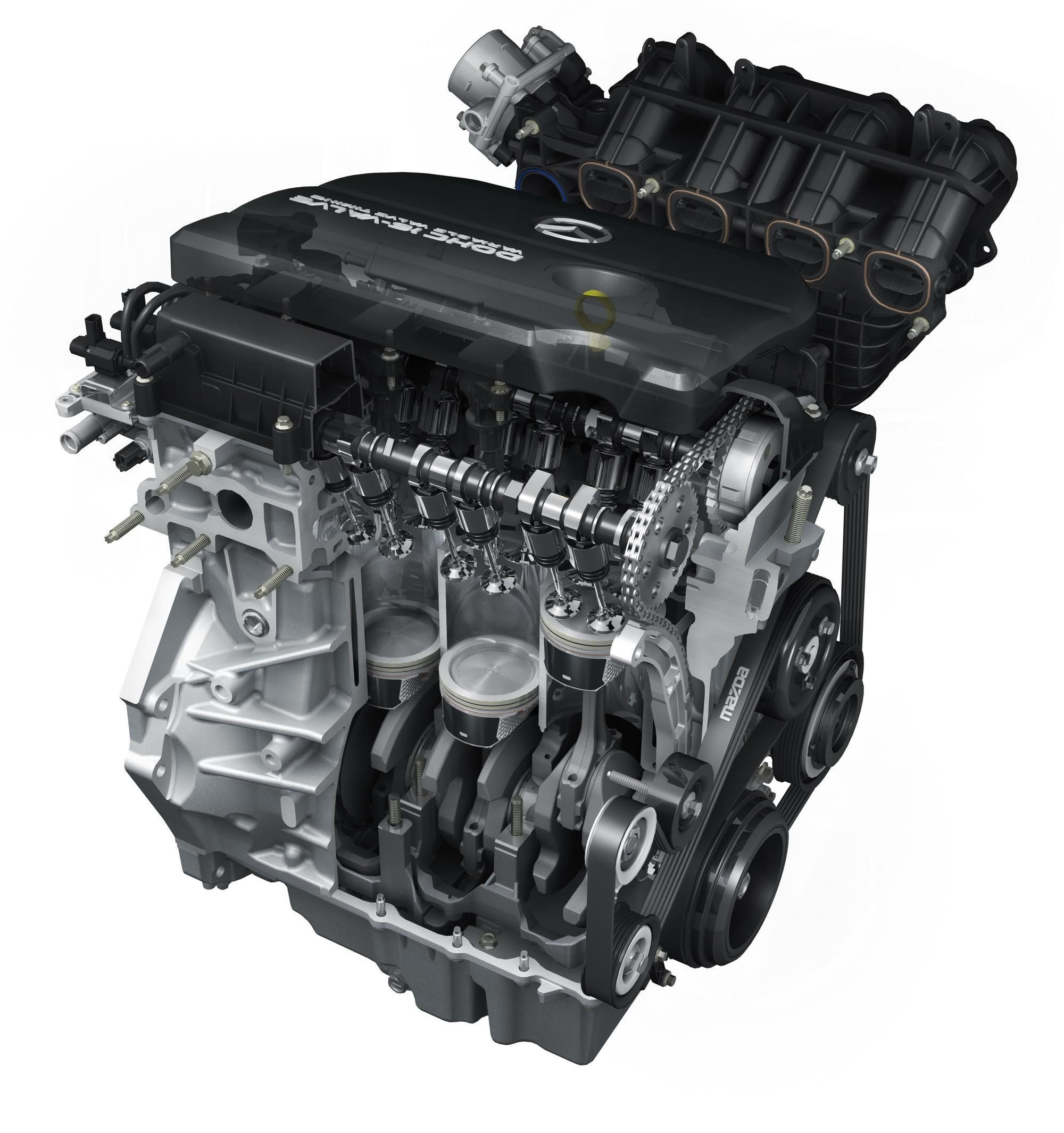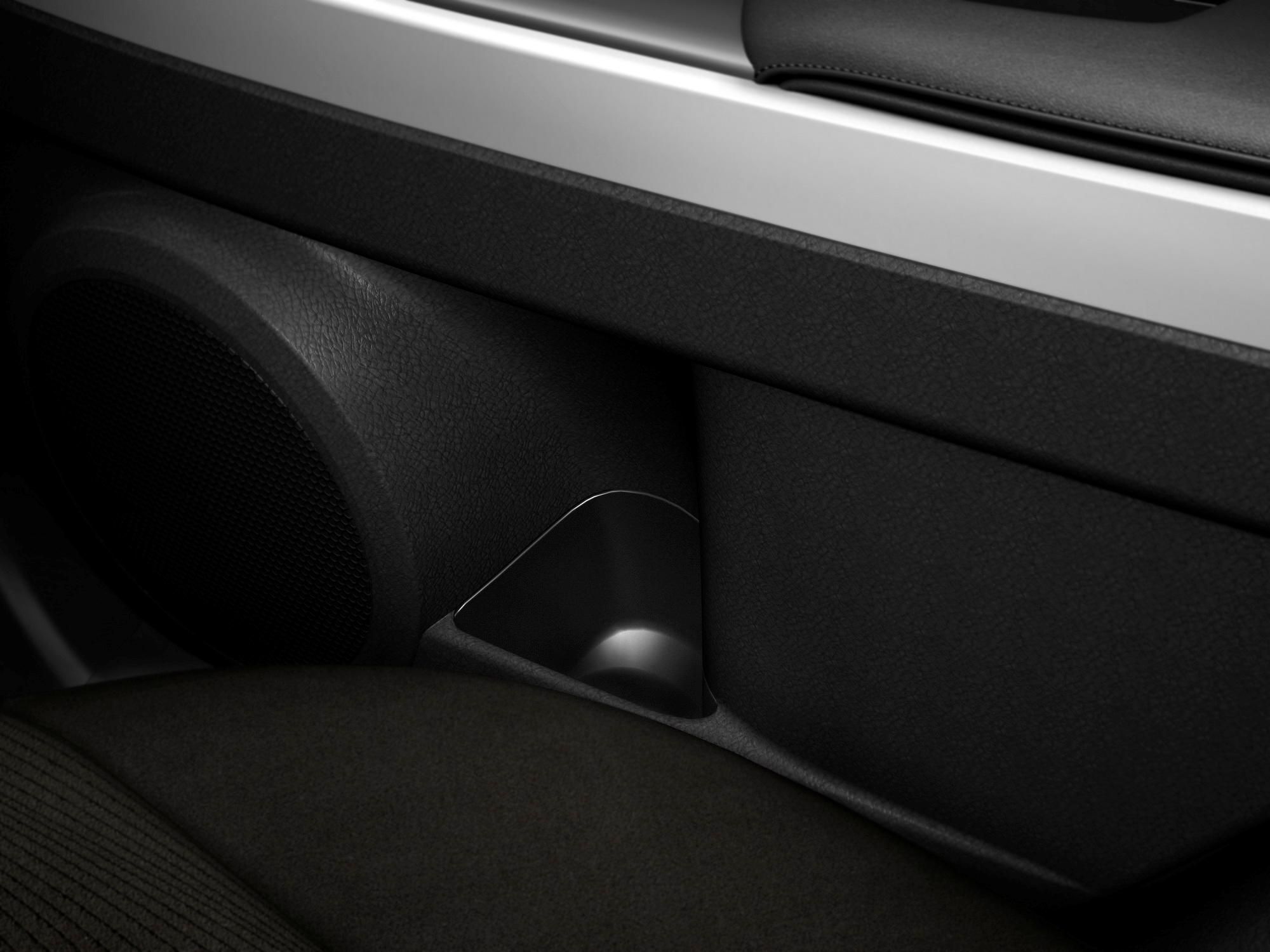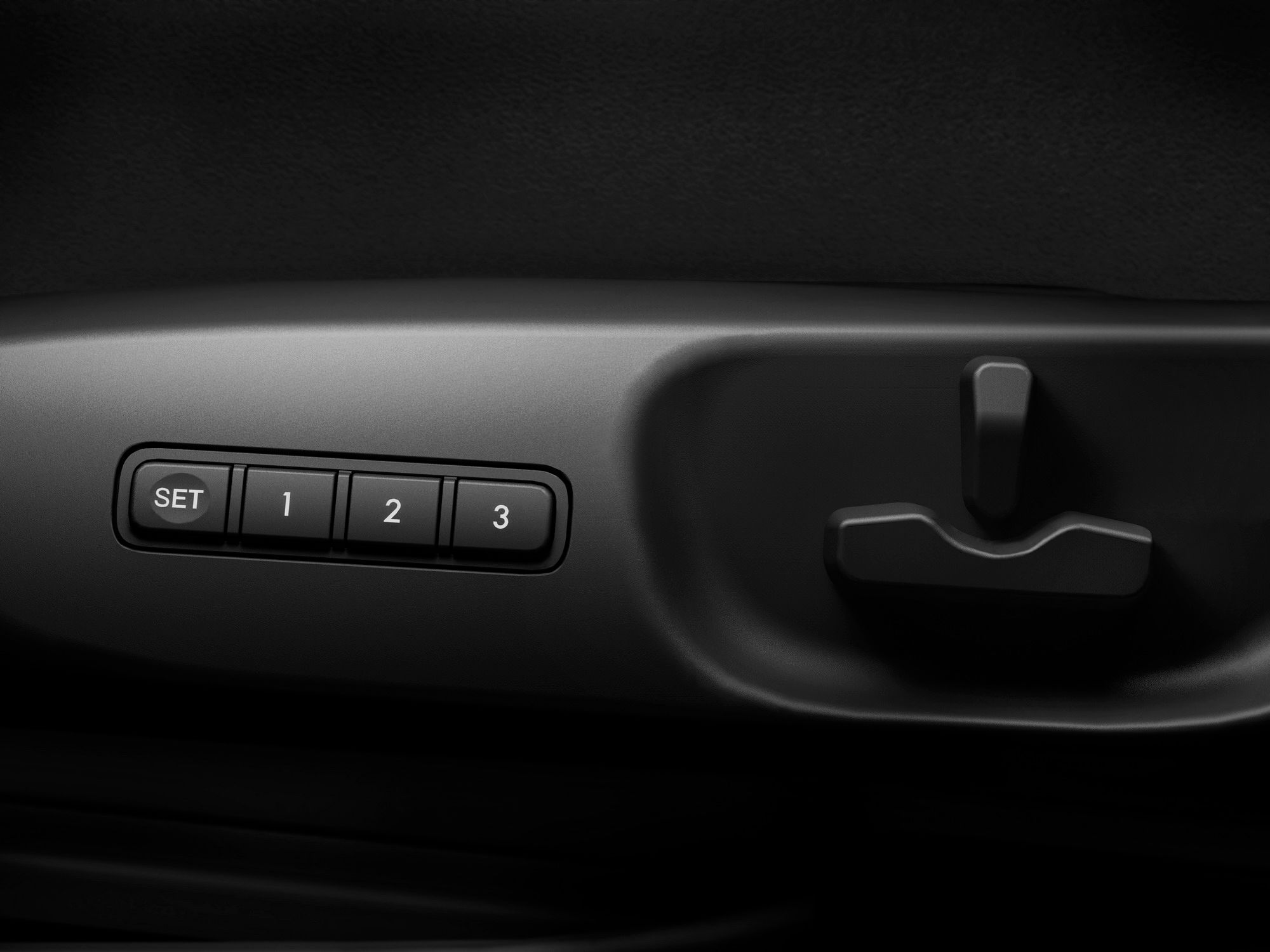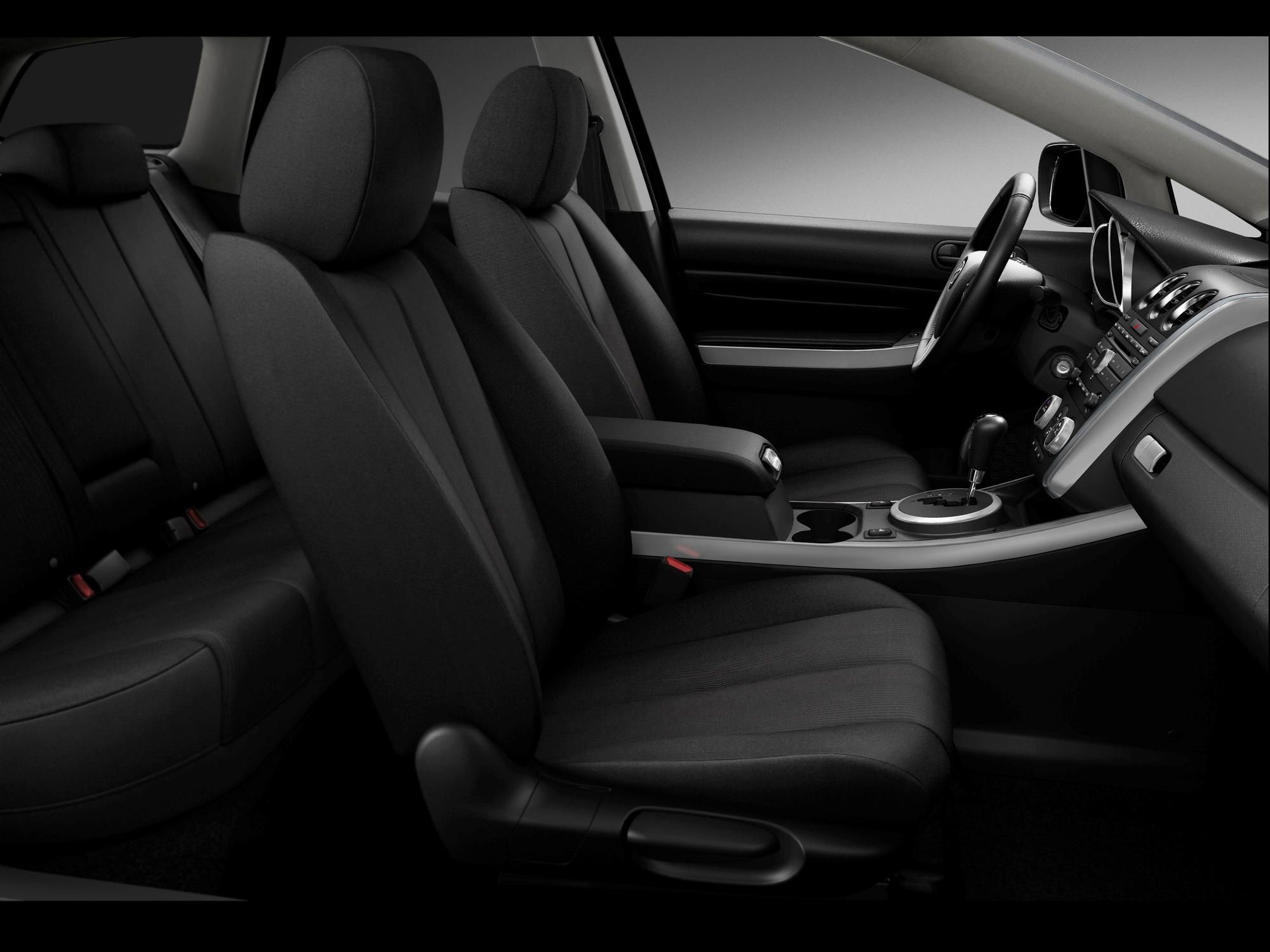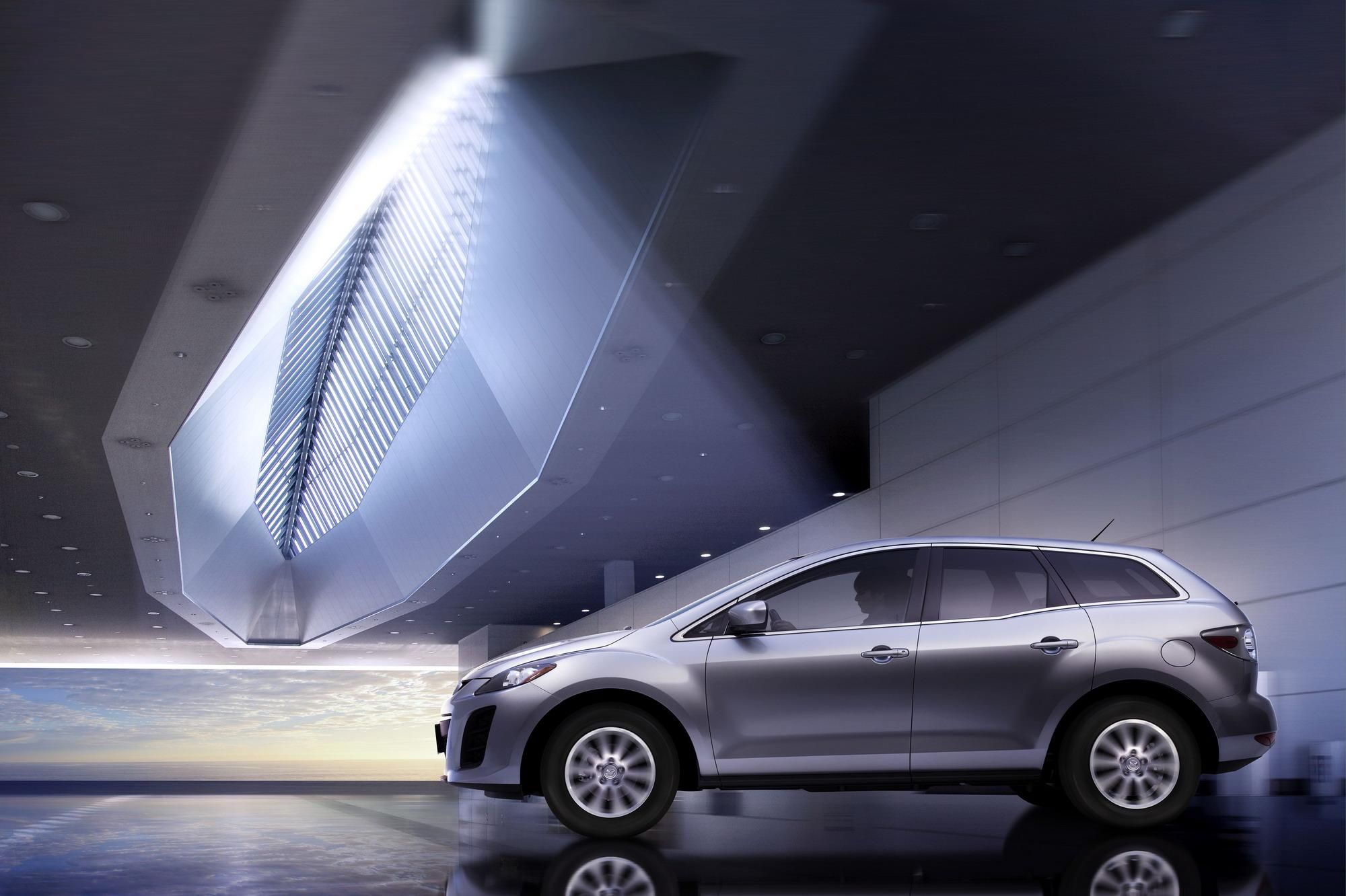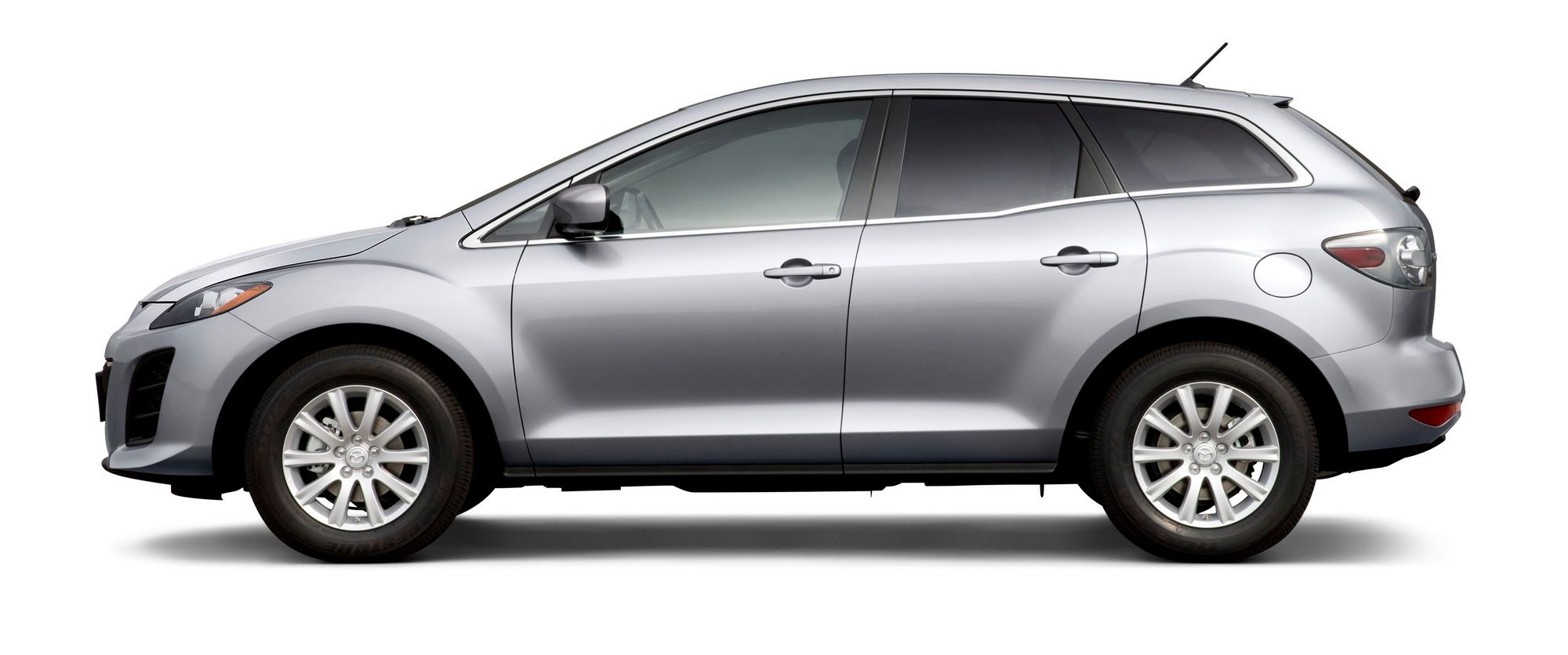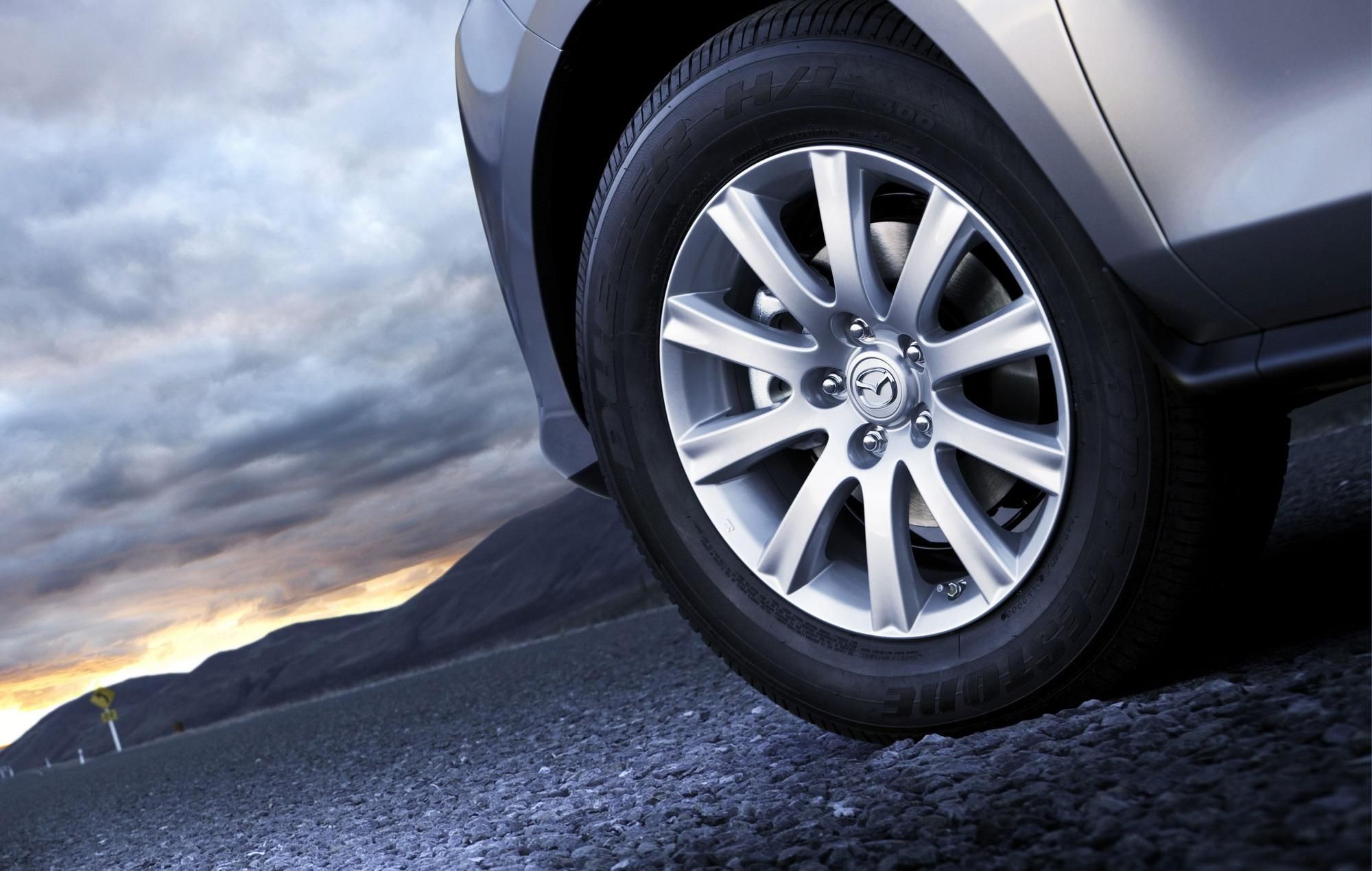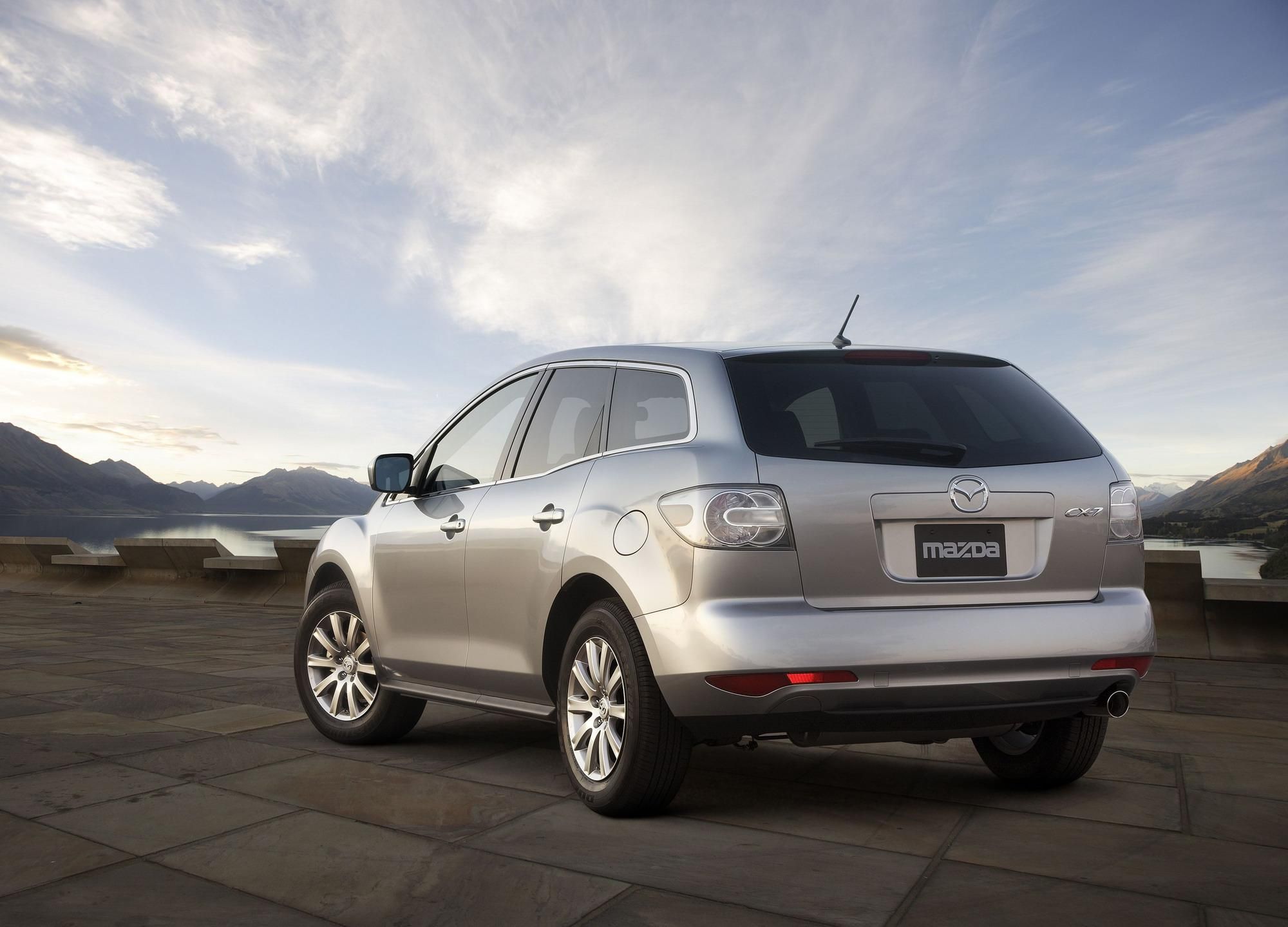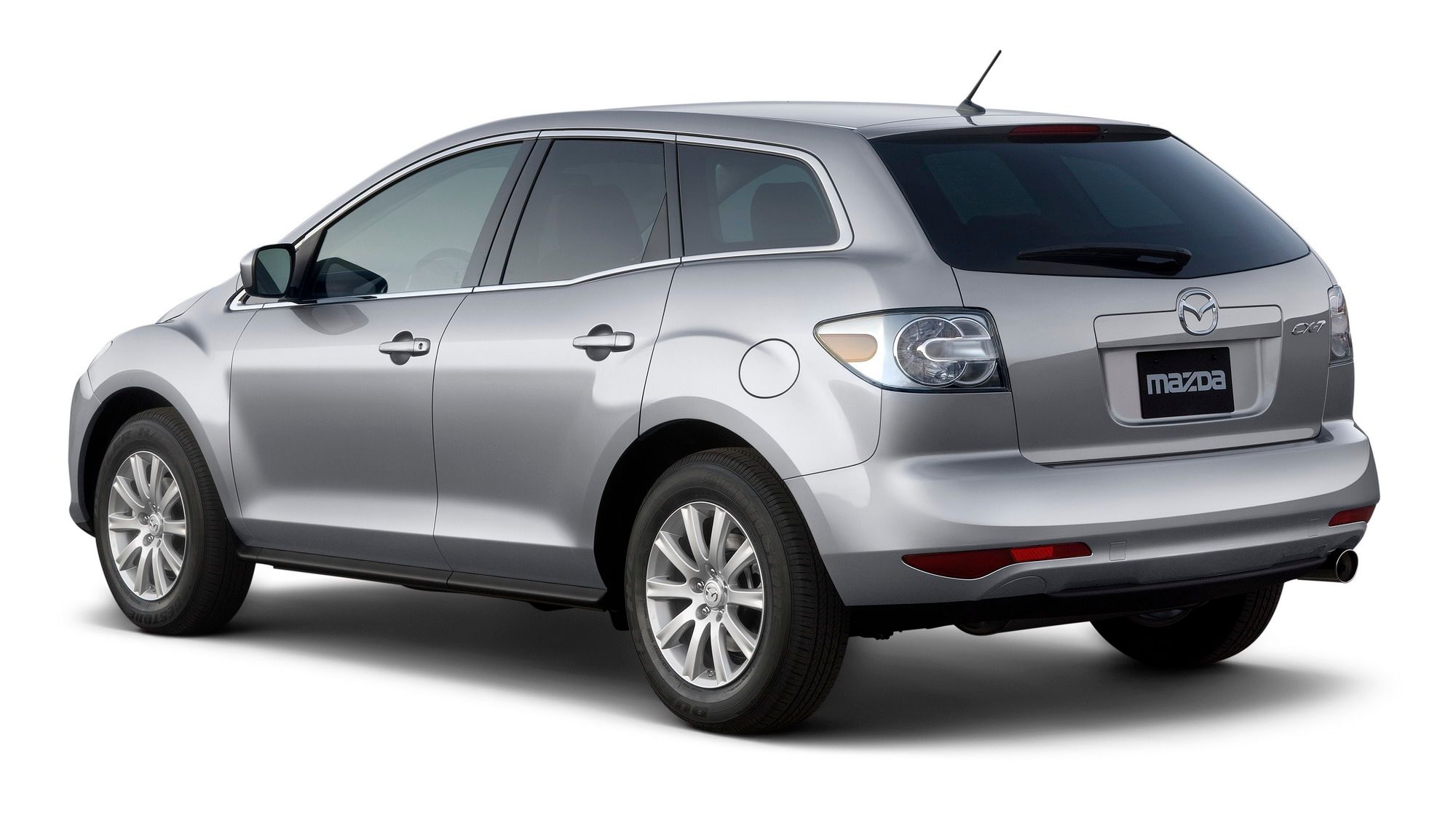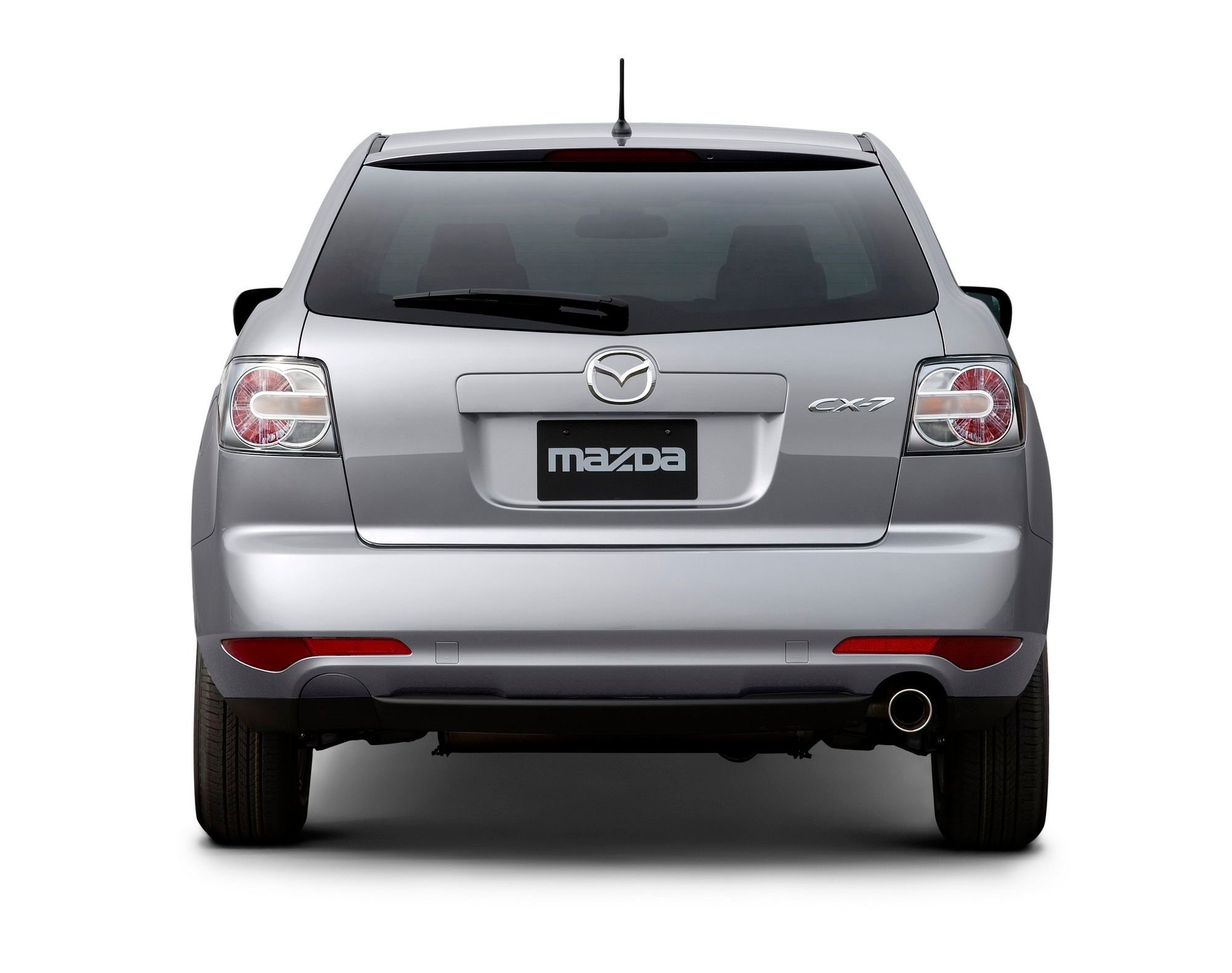Mazda revealed at the Toronto Auto Show the 2010 CX-7. The SUV comes with a subtle facelift and also new engine: a a 161 hp, naturally aspirated 2.5 litre four-cylinder that is also found under the hood of the 2009 Mazda6 and 2010 Mazda3.
The new engine comes with Front-Wheel Drive coupled to a 5-speed automatic transmission. Continuing as the top engine option is the familiar MZR 2.3L DISI Turbo (direct injection DOHC 16-valve four-cylinder) engine. Output remains the same, 244 hp at 5,000 rpm with 258 lb-ft of torque at 2,500 rpm.
The exterior design of the 2010 CX-7 features revised front and rear fascias with the front adopting the larger five-point grille design similar in appearance to recently redesigned RX-8, MX-5 and Mazda3.
Press release after the jump.
2010 Mazda CX-7
- Make: Array
- Model: 2010 Mazda CX-7
- [do not use] Vehicle Model: Array
Press release
Launched in 2006 as a 2007 model, the Mazda CX-7 offers a blend of sports car verve and SUV practicality in a way that few other crossover vehicles can, and has garnered high praise by consumers and media as a true driver's vehicle.
"A key word in the development process of the 2010 CX-7 was refinement," said Masashi Otsuka, Mazda Motor Corporation's CX-7 program manager. "The vehicle we had to start with was already really good and well liked by consumers, so my team didn't have to start over, but simply refine." For 2010, the CX-7 continues to offer more of what has made it a success and adds characteristics of sophistication, sustainability and detail.
To address a customer request, the highlight of Otsuka's team's work for the 2010 model year is the development of a more economical example of the already thrifty CX-7. This model will incorporate an all-new naturally aspirated DOHC 16-valve 2.5-liter MZR four-cylinder engine coupled to a five-speed automatic transmission. The existing MZR 2.3-liter DISI Turbo (direct injection DOHC 16-valve four-cylinder) engine will still be offered in the upper trim levels.
Sold worldwide, the 2010 CX-7 made its debut at the 2009 Canadian International Auto Show in February and made its first appearance in the United States at the 2009 New York International Auto Show.
CHOICE OF TWO DYNAMIC POWERPLANTS
Produced entirely on Mazda-derived platform architecture, the five-passenger
MZR 2.5 I-4 normally aspirated:
For 2010, CX-7 adopts Mazda's MZR 2.5-liter engine, which can also be found in the new MAZDA6 and MAZDA3, and is known for its excellent fuel economy and drivability. The 2.5-liter DOHC inline-four delivers 161 horsepower at 6,000 rpm and offers maximum torque of 161 lb-ft at 3,500 rpm. By coupling this engine to a light-weight, efficient, five-speed automatic transmission and utilizing a front-wheel-drive layout, this new powertrain combination returns fuel economy of 20/28 mpg (city/highway). This drivetrain combination is available on the i SV and i Sport models only, and only with front-wheel-drive.
Advanced features utilized in the MZR-series engines include chain-driven dual overhead camshafts and four valves per cylinder for deep breathing at high revs and efficient torque delivery at lower revs. Counter-rotating balance shafts located in the oil pan provide a dramatic reduction in the vibration and harshness often found in large-displacement four-cylinder engines, and a forged steel crankshaft ensures excellent long-term durability.
Fuel is delivered to the intake ports by an electronically controlled sequential injection system, where the modular ignition coils are positioned directly above the spark plugs for increased efficiency and reduced maintenance and under-hood complexity.
Other lightweight items are the aluminum block and head, the forged powder-metal connecting rods (reduced reciprocating weight), and the injection-molded, nylon-reinforced-plastic intake manifold which also provides smooth internal passages for more efficient air flow. Overall, the normally aspirated 2.5-liter MZR engine delivers excellent off-the-line and overtaking characteristics, and is a strong match for the CX-7s dynamics.
MZR 2.3 DISI Turbo
Continuing to be available, and carried over from the previous model years, the CX-7 also is powered by an award-winning 2.3L DISI (Direct Injection Spark Ignition) turbo engine. Engineered to deliver high performance at all engine and road speeds, along with low exhaust emissions and good fuel economy, the MZR 2.3 DISI turbo-charged engine produces up to an enthusiastic 244 horsepower at 5,000 rpm and 258 lb-ft of torque at only 2,500 rpm.
From 2,000 to 5,000 rpm, more than 90 percent of the engine's maximum torque is available, which makes for a smooth and comfortable driving experience. Unlike other high-performance turbo-charged engines, CX-7's turbo engine is tuned to run on regular fuel.
The DISI MZR engine uses it own specific aluminum block and head construction, including a specific forged crankshaft and connecting rods for long-lasting durability. A large air-to-air intercooler and direct fuel injection cools temperature inside the cylinders and allows use of a relatively high compression ratio without fear of knocking or pinging - "detonation" in industry terms - that reduces durability.
Utilizing extremely high pressure in the fuel injection system - up to 3,000 psi - allows the fuel to be atomized as it is delivered to the cylinders. This shift in the gasoline's state from liquid to vapor in the intake manifold as it is injected into the cylinder provides the substantial cooling effect. The low charge temperature permits the application of a 9.5:1 compression ration, boosting low- and mid-range torque by approximately 10 percent over conventional turbo engines.
Low exhaust emissions are achieved by connecting the catalytic converter directly to the turbocharger to shorten the time required for the catalyst to reach its effective operating temperature. The CX-7 meets stringent federal Tier 2 Bin 5 and California LEV-II emissions standards.
A six-speed Sport AT automatic transmission also provides full manual control demanded by assertive drivers. Shifts are crisp, in keeping with CX-7's sportscar character.
Two drivelines are offered with the DISI turbo engine: Front-Wheel Drive or Mazda's Active Torque-Split All-Wheel- Drive. The latter system uses a computer-controlled coupling integrated with the rear differential to deliver up to half the available torque to the rear wheels on demand.
Sensors monitor engine information, individual wheel speeds, Anti-lock Brake System (ABS) operation, and the CX-7's standard Dynamic Stability Control (DSC) system to optimize torque distribution. Whether the driving conditions are dry and fast or slippery and moderately paced, exceptional stability is assured.
REFINED CHASSIS PROVIDES ENHANCED HANDLING AND RIDE QUALITY
A light, stiff unibody provides the sound foundation for CX-7's smooth ride and agile handling. Computer-Aided-Engineering analysis was used to optimize this structure, delivering high torsional and bending rigidity with minimal weight.
A theme of refinement carries over to the 2010 CX-7's platform architecture by incorporating improvements in body rigidity, lower noise, vibration & harshness (NVH) levels as well as reduced wind noise. Thicker materials, reinforcements and weld bonds (spot welds supplemented by adhesives, first applied in the CX-9) in key areas all contribute to a five percent higher torsional rigidity than the original CX-7 with only a minimal increase in weight. Thicker density insulation in both the engine compartment and interior cabin provide a quieter passenger environment. A-pillars fitted with large moldings reflect an effort to suppress cabin noise generated by side winds blowing across the exterior of the A-pillars.
In front, a perimeter frame mounted to the unibody through six rubber isolators supports the powertrain, the engine-speed-sensitive rack-and-pinion power steering and a low-friction MacPherson strut suspension system. The rear multi-link suspension is similarly mounted in its own subframe and consists of one trailing arm and two lateral locating members per side.
The front and rear dampers have been retuned for 2010 with larger oil-flow openings and are located between the wheel hub and the unibody to provide excellent motion control with minimal friction. Coil springs and anti-roll bars are an integral part of both suspension systems
All of these refinements assist in greater ride comfort, handling and stability, combined with lower NVH throughout the vehicle.
CX-7's four-wheel ventilated disc brake system integrates the Anti-lock Brake System (ABS), Traction Control System (TCS), and Dynamic Stability Control (DSC) functions. It also collaborates with the Active Torque Split All-Wheel Drive to prevent wheel spin on slippery surfaces.
NEW EMOTIONAL SURFACE EXPRESSION
The new 2010 CX-7's styling is based on the athletic design of the current model, but incorporates enhancements for a clearer premium identity and more refined character. The exterior design features a revised lower front grille with a larger five-point grille similar in appearance to those adopted recently on the Mazda RX-8, MX-5 and MAZDA3. CX-7's new front fascia clearly communicates the Mazda brand, and harmonizes it with the latest models in the line-up. For Grand Touring models, new front fog lamp bezels on either side of the grille emphasize the strong visual flow. In addition, Grand Touring models feature enhanced, distinctive details to the front grille, mirror housings and door handles to provide premium identity. At the rear, CX-7 features a revised bumper design.
Wheel sizes include 17-inch, 18-inch and all-new 19-inch alloys, depending on trim level.
The 66-degree windshield angle is sleeker than many sportscars, let alone SUVs. Distinct character lines run through the A-pillars and along the edges of the hood to the front fascia. Prominent front fenders reveal a clear Mazda family identity.
The side profile sports an aggressively rising belt line, curved roof and prominent fender arches, producing Mazda's unique signature. A tapered cabin rests securely on the lower body's broad shoulders. From the rear, the detailed round motif tail lamp and large dual exhaust outlets (available on 2.3-liter DISI Turbo models only; normally aspirated models incorporate a large single outlet) also emphasize the Zoom-Zoom sportscar feature.
This distinctive overall exterior design is well balanced with the aerodynamics of the vehicle. While it provides outstanding aerodynamic performance, this exterior design does not compromise craftsmanship. Panel and component part-gaps are flush and tight. Wiper arms are configured to match the surrounding cowl design and minimize wind noise. Attention to detail makes this car what it is.
INTERIOR DESIGN - QUALITY DETAILING
The updated premium look on the outside is continued on the inside of the vehicle with quality detailing that delivers a sporty yet highly refined cabin. A new steering wheel with integrated steering-wheel mounted controls for the audio, Bluetooth® telephone and cruise-control greets the driver upon entry. A new design for the blackout meters of the meter cluster features newly introduced blue-ring illumination, white pointers and three-dimensional dials to produce a heightened sense of quality.
CX-7's unique double-roof instrument panel is modified as well. The upper roof is no longer straight but now adopts a gently undulating shape. This was changed so designers could install the new Multi Information Display (MID) positioned in the center and to the right of the driver for easy reading. The MID offers navigation (standard on Grand Touring trim), trip computer functions, rear-view camera (available on Touring and Sport, standard on Grand Touring) and maintenance information. It is placed clearly in the driver's line of sight, requiring only a slight refocus from the road ahead to see directional instructions or check the radio station readout. There are two types of LCD screens available for the MID - a 3.5-inch monochrome dot matrix screen or a bright, high-resolution 4.1-inch color screen, which is standard on Grand Touring models and available as an option on Sport and Touring models.
Piano black or metallic edges are added to the center panel to convey a sense of refinement.
The CX-7 facelift interior was developed with new materials placed at various locations around the cabin to give an even more premium look and feel. The rings on the side air conditioner vents are specially plated with anti-glare chrome. New front and rear door armrests are introduced as well, which incorporate soft pads for enhanced quality feel and more comfort than before.
Advanced equipment is introduced on the 2010 CX-7 that provides even more functionality to the driver and passengers. CX-7 features Bluetooth® compatibility (all models except SV), which provides a wireless connection for Bluetooth® -compatible mobile phones and portable audio devices. For audio devices not compatible with Bluetooth®, the auxiliary jack from the current model is also available.
The front seats of Grand Touring models gain an available three-position memory function for the driver's seat and a four-way power adjustable passenger's seat.
A Blind Spot Monitoring System, similar to the one found on the MAZDA6 and CX-9 is now available to help the driver avoid collisions with other vehicles when changing lanes or merging with traffic. At 20 mph or more, radar sensors monitor an area that extends on each side of the vehicle. When a vehicle or other object enters the detection area, a warning lamp in the door mirror on the relevant side comes on to alert the driver. If the driver should then switch on the turn signal, the system will emit a warning sound and flash the lamp.
-----
Specifications
|
2010 CX-7 |
CX-7 i |
CX-7 s |
|
Engine |
||
|
Engine type |
2.5-liter DOHC 16-valve 4-cylinder with VVT |
2.3L DOHC DISI turbocharged 16-valve 4-cylinder with VVT |
|
Horsepower |
161 hp @ 6000 rpm |
244 hp @ 5000 rpm |
|
Torque (lb-ft) |
161 lb-ft @ 3500 rpm |
258 lb-ft @ 2500 rpm |
|
Redline |
6500 rpm |
6700 rpm |
|
Displacement (cc) |
2488 |
2260 |
|
Bore x stroke (mm) |
89 x 100 |
87.5 x 94 |
|
Compression ratio |
9.7:1 |
9.5:1 |
|
Fuel system |
Electronically-controlled multi-port fuel injection |
Direct-Injection Spark Ignition (DISI) |
|
Recommended fuel |
Regular unleaded |
Premium unleaded (91 octane) |
|
Valvetrain |
4 valves per cylinder with variable intake valve timing (VVT) |
4 valves per cylinder with variable intake valve timing (VVT) |
|
Engine block |
Aluminum-alloy |
Aluminum-alloy |
|
Cylinder head |
Aluminum-alloy |
Aluminum-alloy |
|
Fuel economy |
||
|
Front-wheel drive (city/hwy) |
20/28 |
18/25 |
|
All-wheel drive (city/hwy) |
17/23 |
|
|
Drive Train |
||
|
Type |
Front-wheel drive (FWD) |
Front-wheel drive (FWD) or Active Torque Split All-Wheel Drive (AWD) |
|
Automatic transmission |
5-speed Sport with Adaptive Shift Logic and manual-shift mode |
6-speed Sport with Adaptive Shift Logic and manual-shift mode |
|
Chassis |
||
|
Brakes |
4-wheel disc brakes |
4-wheel disc brakes |
|
- Front |
11.7-inch vented disc |
11.7-inch vented disc |
|
- Rear |
11.9-inch vented disc |
11.9-inch vented disc |
|
- ABS |
4-wheel, 4-channel with Electronic Brakeforce Distribution (EBD) and Brake Assist |
4-wheel, 4-channel with Electronic Brakeforce Distribution (EBD) and Brake Assist |
|
Steering type |
Power rack-and-pinion with variable assist |
Power rack-and-pinion with variable assist |
|
Power assist |
Engine-speed-sensitive variable power assist |
Engine-speed-sensitive variable power assist |
|
Overall steering ratio |
15.8:1 |
15.8:1 |
|
Steering wheel turns-to-lock |
2.9 |
2.9 |
|
Suspension |
4-wheel independent |
4-wheel independent |
|
- Front |
MacPherson strut with stabilizer bar |
MacPherson strut with stabilizer bar |
|
- Rear |
Multilink with stabilizer bar |
Multilink with stabilizer bar |
|
Wheel size (in) |
17 x 7.0 |
18 x 7.5; 19 x 7.5 |
|
Tire size |
P215/70R17 all-season radial |
P235/60R18 all-season radial, P235/55R19 all-season radial |
|
Weights / Capacities / Aerodynamics |
||
|
Curb weight (lbs) |
||
|
- FWD |
3496 |
3787 |
|
- AWD |
4001 |
|
|
Towing capacity (lbs) |
1500 |
2000 |
|
Fuel capacity (gallons) |
16.4 |
18.2 |
-----
Prices
|
Axle |
Trim |
Specification |
MSRP |
|
FWD |
i SV |
2.5L ENGINE WITH 5-SPEED SPORT AUTOMATIC TRANSMISSION |
$21,550 |
|
i SPORT |
2.5L ENGINE WITH 5-SPEED SPORT AUTOMATIC TRANSMISSION |
$22,340 |
|
|
s TOURING |
2.3L DISI TURBO ENGINE WITH 6-SPEED SPORT AUTOMATIC TRANSMISSION |
$25,800 |
|
|
s GRAND TOURING |
2.3L DISI TURBO ENGINE WITH 6-SPEED SPORT AUTOMATIC TRANSMISSION |
$31,185 |
|
|
AWD |
s TOURING |
2.3L DISI TURBO ENGINE WITH 6-SPEED SPORT AUTOMATIC TRANSMISSION |
$27,500 |
|
s GRAND TOURING |
2.3L DISI TURBO ENGINE WITH 6-SPEED SPORT AUTOMATIC TRANSMISSION |
$32,885 |
Packages and option
|
Code |
Package |
Application |
MSRP |
|
1CP |
Sport Convenience Package - Heated Front Seats, Power Driver Seat, Power sliding glass moonroof with interior sunshade Color Multi-Information Display (MID) with Rearview Camera, Automatic Climate Control |
i Sport |
$1,750 |
|
JCP |
Crystal White Pearl Mica Paint |
All |
$200 |
|
1TE |
Touring Technology Package - Power Sliding Glass Moonroof with Interior Sunshade, In-Dash 6-Disc CD Changer, 9-Speaker Bose Centerpoint Surround System with AudioPilot, Color Multi-Information Display (MID) with Rearview Camera, SIRIUS Satellite Radio with 6 Month Subscription (not available in Alaska and Hawaii) Automatic Climate Control |
s Touring |
$2,185 |
Accessories
|
Code |
Option |
Application |
MSRP |
|
1RV |
Rearview Camera |
i SV, i Sport, s Touring (NA with 1CP on i Sport & 1TE on sTouring) |
$665 |
|
CGN |
Cargo Net |
All |
$50 |
|
CGT |
Cargo Tray |
All |
$70 |
|
DVD |
DVD Entertainment System (Overhead type) |
All |
$1,200 |
|
FLA |
All-Weather Floor Mats |
All |
$80 |
|
FOG |
Fog Lights |
All Except s GT |
$400 |
|
MND |
Moonroof Deflector |
All except i SV, (Requires 1CP on i Sport & 1TE on s Touring) |
$70 |
|
MRC |
Compass / Auto Dim Mirror |
All Except s GT (N/A w/MRH) |
$200 |
|
MRH |
Compass / Auto Dim Mirror w/ Homelink |
All Except s GT (N/A w/MRC) |
$275 |
|
RBG |
Rear Bumper Guard (Late Availability) |
All |
$125 |
|
RCC |
Retractable Cargo Cover |
i SV, i Sport |
$125 |
|
RSE |
Remote Engine Start |
All |
$350 |
|
RSP |
Rear Spoiler |
All |
$400 |
|
SAT |
SIRIUS Satellite Radio with 6-month Subscription |
i SV, i Sport, s Touring (NA with 1TE on sTouring) |
$430 |
|
SCP |
Scuff Plates, Stainless |
All |
$145 |
|
SGB |
Splash Guard Front / Rear |
All |
$150 |
|
THH |
Trailer Hitch Receiver & Harness |
i SV, i Sport, s Touring (NA with 1CP on i Sport & 1TE on sTouring) |
$350 |
|
TTW |
Trailer Hitch Receiver, Class II |
All except i SV, (Requires 1CP on i Sport & 1TE on s Touring) |
$335 |
|
WLK |
Wheel Locks |
All |
$50 |
-----
Competitors and press reviews
"Most entry-level SUVs and crossovers offer a dull driving experience. Not so for the CX-7. Mazda says it puts the "soul of a sports car" into everything it builds. In the CX-7 that translates to a fun driving character. Because of the high seating position, drivers will feel more lean or roll in turns than in a sport sedan. However, the CX-7 stays fairly flat and remains composed in most driving situations. Steering is more direct and responsive than in any competitor, and the brakes feel natural and solid." (MSN Autos)
"On the other hand, even though the 2.5 models are equipped with soft-riding 70-series tires on 17-inch alloy wheels (turbo models offer 18- and 19-inch wheels with lower profile rubber), responses are prompt by the standards of this class, with steering that delivers better-than-average road feel. Maybe that’s not particularly zoomy, but there are other benefits. For example, the ride quality is a shade better than in the turbo editions, and interior noise levels are distinctly lower." (CarAndDriver)
"Overall, shoppers are going to find the 2.5 adequate for most needs, but for those who buy the 2010 Mazda CX-7 with its sporty image in mind the turbo engine still better fits the appearance. During normal driving, the 2.3-liter turbo engine accelerates the CX-7 almost effortlessly; downshifts aren't always necessary as 90 percent of peak torque is achieved from 2000 all the way up to 5000 rpm. However, the tradeoff is a slightly coarser sound versus the 2.5." (TheCarConnection)
Competitors
The 2010 Nissan Murano is offered in three trim levels – S, SL and LE – in a choice of front-wheel drive or with an Intuitive All-Wheel Drive system, including a new Murano LE FWD model. Each features a standard 265-horsepower 3.5-liter V6 engine and refined Xtronic CVT. The crossover is on sale at a price starting from $28,050 to $38,180.
The Equinox is powered by a choice of two engines: a 2.4L Ecotec direct injected I-4 engine estimated at 182 hp and 30 mpg highway, 21 mpg city and a 3.0L DOHC direct injected V-6 engine estimated at 255 hp and 25 mpg highway, 18 mpg city. Prices start at $23,185.
The 2010 Outback is offered with a choice of the 170 hp 2.5-liter boxer four or the 256 hp 3.6-liter boxer six. Subaru is offering a new 6-speed manual transmission or the available new Lineartronic CVT equipped with a manual mode and steering wheel paddle shifters. Prices range from $22,995 to $28,295.
Conclusion
You will ask why a crossover an not a sedan? While the answer to that question is more than obvious we want to tell you why the CX-7. Of course the car is offering all the interior space you might need, but in the same time the ride of a sedan, but with agile moves. depending on your need you might opt for either an entry-level CX-7, or a turbocharged 4-cylinder versions if you are looking for more power and fun in the same time.
The car's responses are prompt, and thanks to a high seating position, drivers will feel more lean or roll in turns than in a sport sedan. An advantage of the car is that the steering is more direct and responsive than in any competitor, and the brakes feel natural and solid. So, driving the CX-7 is quite fun.
And if you add the fact that it has the lowest base price then you should definitely go for it!


